Sierra Leone
Sierra Leone (/siˌɛrə liˈoʊn(i)/ (![]()
Republic of Sierra Leone | |
|---|---|
Motto: "Unity, Freedom, Justice" | |
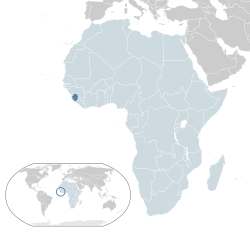 Location of Sierra Leone (dark blue) – in Africa (light blue & dark grey) | |
| Capital and largest city | Freetown 8°29.067′N 13°14.067′W |
| Official languages | English, Krio |
| Religion | Islam (78%) Christianity (21%)[1] |
| Demonym(s) | Sierra Leonean |
| Government | Unitary presidential constitutional republic |
| Julius Maada Bio | |
• Vice-President | Mohamed Juldeh Jalloh |
• Chief Minister | David J. Francis |
• Speaker of Parliament | Abass Chernor Bundu |
• Chief Justice | Desmond Babatunde Edwards[2] |
| Legislature | Parliament |
| Independence | |
• from the United Kingdom | 27 April 1961 |
• Republic declared | 19 April 1971 |
| Area | |
• Total | 71,740 km2 (27,700 sq mi) (117th) |
• Water (%) | 1.1 |
| Population | |
• 2015 census | 7,092,113[3] (102nd) |
• Density | 97/km2 (251.2/sq mi) (114tha) |
| GDP (PPP) | 2018 estimate |
• Total | $12.177 billion[4] |
• Per capita | $1,608[4] |
| GDP (nominal) | 2018 estimate |
• Total | $3.824 billion[4] |
• Per capita | $505[4] |
| Gini (2018) | 35.7[5] medium |
| HDI (2018) | low · 181st |
| Currency | Leone (SLL) |
| Time zone | UTC (GMT) |
| Driving side | rightb |
| Calling code | +232 |
| ISO 3166 code | SL |
| Internet TLD | .sl |
| |
Sierra Leone achieved independence from Britain on 27 April 1961, and Milton Margai became the first Prime Minister. Margai's political party was the Sierra Leone People's Party (SLPP) which, under the leadership of Albert Margai, narrowly lost the 1967 Sierra Leone parliamentary elections to the main opposition party of the All People's Congress (APC), led by Siaka Stevens.
Stevens was a political strongman who ruled Sierra Leone from 1967 to 1985 when he retired from politics due to poor health. On 19 April 1971, Stevens' government abolished Sierra Leone's parliamentary system and declared Sierra Leone a presidential republic. From 1978 to 1985, president Stevens’ APC party was the only legal political party in Sierra Leone. The multiparty democratic constitution of Sierra Leone was adopted in 1991 by the government of President Joseph Saidu Momoh, Stevens' hand-picked successor, just as the rebel group Revolutionary United Front led by Foday Sankoh launched a brutal civil war in the country.
On 29 April 1992, a group of Junior soldiers in the Sierra Leone Army led by Captain Valentine Strasser overthrew President Momoh, and Sierra Leone was under military rule from 1992 to 1996 during the civil war. The country returned to a democratically elected government when the military Junta under Brigadier General Julius Maada Bio handed the presidency to Ahmad Tejan Kabbah of the SLPP after his victory in the 1996 election. However, the Sierra Leone military overthrew President Kabbah in a coup on 25 May 1997, and Major General Johnny Paul Koroma became the country's military head of state. A coalition of West African Ecowas armed forces led by Nigeria then reinstated President Kabbah by military force in February 1998, and the leaders of the coup were executed after they were sentenced to death by a Sierra Leone military court. In January 2002, President Kabbah announced the end of the civil war with the help of Ecowas, the British government, the African Union, and the United Nations. Sierra Leone has had an uninterrupted democratic government from 1998 to present.
Sixteen ethnic groups inhabit Sierra Leone, each with its own language and customs. The two largest and most influential are the Temne and Mende people. The Temne are predominantly found in the northwest and the Mende in the southeast. About two per cent of the country's population are the Krio people, who are descendants of freed African American and West Indian slaves. English is the official language used in schools and government administration, however, the Krio is the most widely spoken language across Sierra Leone, and is spoken by 98% of the country's population. The Krio language unites all the ethnic groups in the country, especially in their trade and social interaction.
Sierra Leone is 77 per cent Muslim, with an influential Christian minority of 22 per cent.[13] The country is regarded as one of the most religiously tolerant countries in the world. Muslims and Christians collaborate and interact with each other very peacefully, and religious violence is very rare. The major Christian and Muslim holidays are official public holidays, including Christmas, Easter, Eid al-Fitr, and Eid al-Adha.[14][15]
Sierra Leone has relied on mining for its economic base, especially of diamonds. It is also among the largest producers of titanium and bauxite and a major producer of gold, and it has one of the world's largest deposits of rutile. The nation is home to the third-largest natural harbour in the world. Despite this natural wealth, 53 per cent of its population lived in poverty in 2011.[16] Sierra Leone is a member of many international organisations, including the United Nations, the African Union, the Economic Community of West African States (ECOWAS), the Mano River Union, the Commonwealth of Nations, the African Development Bank, and the Organisation of Islamic Cooperation.
Etymology
The country takes its name from the Lion Mountains near Freetown. Originally named Serra Leoa (Portuguese for "Lioness Mountains") by Portuguese explorer Pedro de Sintra in 1462, the modern name is derived from the Italian spelling, which was introduced by Venetian explorer Alvise Cadamosto and subsequently copied by other European mapmakers.[17]
History
Early history
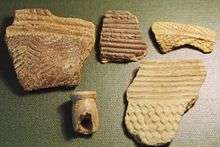
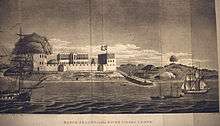

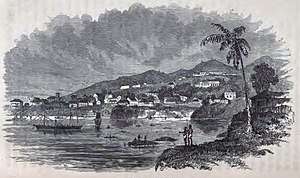
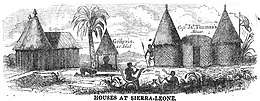
Archaeological finds show that Sierra Leone has been inhabited continuously for at least 2,500 years,[19] populated successively by societies who migrated from other parts of Africa.[20] The people adopted the use of iron by the 9th century and by 1000 AD agriculture was being practised along the coast.[21] The climate changed considerably and boundaries among different ecological zones changed as well, affecting migration and conquest.[22]
Sierra Leone's dense tropical rainforest and swampy environment was considered impenetrable; it was also host to the tsetse fly, which carried a disease fatal to horses and the zebu cattle used by the Mande people. This environmental factor protected its people from conquests by the Mande and other African empires.[22][23] This also reduced the Islamic influence of the Mali Empire but Islam, introduced by Susu traders, merchants and migrants from the north and east, became widely adopted in the 18th century.[24]
European trading
European contacts within Sierra Leone were among the first in West Africa in the 15th century. In 1462, Portuguese explorer Pedro de Sintra mapped the hills surrounding what is now Freetown Harbour, naming the shaped formation Serra da Leoa or "Serra Leoa" (Portuguese for Lioness Mountains).[25] The Spanish rendering of this geographic formation is Sierra Leona, which later was adapted and, misspelled, became the country's current name. Although according to the professor C. Magbaily Fyle this could have been a misinterpretation of historians: according to him, there has been evidence of travellers calling the region Serra Lyoa well before 1462, the year when Sintra first arrived. This would imply that the identity of the person who named Sierra Leone is unknown.[26]
Soon after Sintra's expedition, Portuguese traders arrived at the harbour. By 1495 they had built a fortified trading post on the coast.[27] The Dutch and French also set up trade here, and each nation used Sierra Leone as a trading point for slaves brought by African traders from interior areas undergoing wars and conflicts over territory.[28] In 1562, the English initiated the Triangle Trade when admiral Sir John Hawkins of the Royal Navy transported 300 enslaved Africans – acquired "by the sword and partly by other means" – to the Spanish colony of Santo Domingo on Hispaniola in the Caribbean Sea area of the West Indies islands, where he sold them.[29]
Early colonies
In the late 18th century, many African-Americans claimed the protection of the British Crown. There were thousands of these Black Loyalists, people of African descent who joined the British military forces during the American Revolutionary War.[30] Many of these Loyalists had been slaves who escaped to join the British, lured by promises of freedom (emancipation). The official documentation known as the Book of Negroes lists thousands of freed slaves whom the British evacuated from the nascent United States and resettled in colonies elsewhere in British North America (north to Canada, or south to the West Indies).
In 1787 the British Crown founded a settlement in Sierra Leone in what was called the "Province of Freedom". It intended to resettle some of the "Black Poor of London", some of whom were African-Americans freed by the British during the war. About 400 blacks and 60 whites reached Sierra Leone on 15 May 1787. The group also included some West Indians of African descent from London. After they established Granville Town, most of the first group of colonists died, owing to disease and warfare with the indigenous African peoples (Temne), who resisted their encroachment. The 64 remaining colonists established a second Granville Town.[31][32]
Following the American Revolution, more than 3,000 Black Loyalists had also been settled in Nova Scotia, where they were finally granted land. They founded Birchtown, Nova Scotia, but faced harsh winters and racial discrimination from nearby Shelburne, Nova Scotia. Thomas Peters pressed British authorities for relief and more aid; together with British abolitionist John Clarkson, the Sierra Leone Company was established to relocate Black Loyalists who wanted to take their chances in West Africa. In 1792 nearly 1200 persons from Nova Scotia crossed the Atlantic to build the second (and only permanent) Colony of Sierra Leone and the settlement of Freetown on 11 March 1792. In Sierra Leone they were called the Nova Scotian Settlers, the Nova Scotians, or the Settlers.
The Settlers built Freetown in the styles they knew from their lives in the American South; they also continued American fashion and American manners. In addition, many continued to practice Methodism in Freetown. Black settlers in Sierra Leone enjoyed much more autonomy in that they were more politically engaged. Black immigrants elected different levels of political representatives, 'tithingmen', who represented each dozen settlers, and 'hundreders' who represented larger amounts. This sort of representation was not available in Nova Scotia.[33] The initial process of society-building in Freetown, however, was a harsh struggle. The Crown did not supply enough basic supplies and provisions, and the Settlers were continually threatened by illegal slave trading and the risk of re-enslavement.[34] In the 1790s, the Settlers, including adult women, voted for the first time in elections.[35] The Sierra Leone Company, controlled by London investors, refused to allow the settlers to take freehold of the land. In 1799 some of the settlers revolted. The Crown subdued the revolt by bringing in forces of more than 500 Jamaican Maroons, whom they transported from Cudjoe's Town (Trelawny Town) via Nova Scotia in 1800. Led by Colonel Montague James, the Maroons helped the colonial forces to put down the revolt, and in the process the Jamaican Maroons in Sierra Leone secured the best houses and farms.[36]
On 1 January 1808, Thomas Ludlam, the Governor of the Sierra Leone Company and a leading abolitionist, surrendered the Company's charter. This ended its 16 years of running the Colony. The British Crown reorganised the Sierra Leone Company as the African Institution; it was directed to improve the local economy. Its members represented both British who hoped to inspire local entrepreneurs and those with interest in the Macauley & Babington Company, which held the (British) monopoly on Sierra Leone trade.[37]
At about the same time (following the abolition of the slave trade in 1807), British crews delivered thousands of formerly enslaved Africans to Freetown, after liberating them from illegal slave ships. These Liberated Africans or recaptives were sold for $20 a head as apprentices to the white settlers, Nova Scotian Settlers, and the Jamaican Maroons. Some of the recaptives who were not sold as apprentices were forced to join the Navy. Many recaptives were treated poorly and even abused because some of the original settlers considered them their property. Cut off from their various homelands and traditions, the Liberated Africans were forced to assimilate to the Western styles of Settlers and Maroons. For example, some of the recaptives were forced to change their name to a more Western sounding one. Though some people happily embraced these changes because they considered it as being part of the community, some were not happy with these changes and wanted to keep their own identity. Many recaptives were so unhappy that they risked the possibility of being sold back into slavery by leaving Sierra Leone and going back to their original villages.[38] They built a flourishing trade in flowers and beads on the West African coast.
These returned Africans were from many areas of Africa, but principally the west coast. During the 19th century, freed black Americans, some Americo Liberian 'refugees', and particularly West Indians, also immigrated and settled in Freetown. Together these peoples created a new creole ethnicity called the Krio people (initially called Creoles) and a trading language, Krio, which became commonly used among many of the ethnicities in the country.
Colonial era (1800–1961)
The settlement of Sierra Leone in the 1800s was unique in that the population was composed of displaced Africans who were brought to the colony after the British abolition of the slave trade in 1807. Upon arrival in Sierra Leone, each "recaptive" was given a registration number, and information on their physical qualities would be entered into the Register of Liberated Africans. However, oftentimes the documentation would be overwhelmingly subjective and would result in inaccurate entries, making them difficult to track. In addition, differences between the Register of Liberated Africans of 1808 and the List of Captured Negroes of 1812 (which emulated the 1808 document) revealed some disparities in the entries of the recaptives, specifically in the names; many recaptives decided to change their given names to more anglicised versions which contributed to the difficulty in tracking them after they arrived in Sierra Leone.
According to the British Act for the Abolition of the Slave Trade in 1807, the recaptives could be subject to apprenticeships led by British colonists in Sierra Leone and the males enlisted into the Army or Navy. In many instances, the recaptives who were assigned to apprenticeships were sold for $20, giving the apprenticeship system qualities similar to slavery.[39] It is documented that the recaptive apprentices were unpaid and the settlers who they were appointed to had devices which could be used to discipline them, namely sticks. According to Suzanne Schwartz, a historian on colonial Sierra Leone, in June 1808 a group of 21 men and women ran away to the nearby native settlement of Robiss and upon recapture were imprisoned by the settlers in Sierra Leone, thus contributing to the slavery-like qualities of the apprenticeship system.[39]
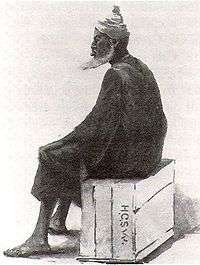
In the early 19th century, Freetown served as the residence of the British colonial governor of the region, who also administered the Gold Coast (now Ghana) and the Gambia settlements. Sierra Leone developed as the educational centre of British West Africa. The British established Fourah Bay College here in 1827, which rapidly became a magnet for English-speaking Africans on the West Coast. For more than a century, it was the only European-style university in western Sub-Saharan Africa.
.jpg)
The British interacted mostly with the Krios in Freetown, who did most of the trading with the indigenous peoples of the interior. In addition, educated Krios held numerous positions in the colonial government, giving them status and good-paying positions. Following the Berlin Conference of 1884–1885, the UK decided that it needed to establish more dominion over the inland areas, to satisfy what was described by the European powers as "effective occupation" of territories. In 1896 it annexed these areas, declaring them the Sierra Leone Protectorate.[40] With this change, the British began to expand their administration in the region, recruiting British citizens to posts, and pushing Krios out of positions in government and even the desirable residential areas in Freetown.[40]
In addition, the British annexation of the Protectorate interfered with the sovereignty of indigenous chiefs. They designated chiefs as units of local government, rather than dealing with them individually as had been previous practice. They did not maintain relationships even with longtime allies, such as Bai Bureh, chief of Kasseh, a community on the Small Scarcies River. He was later unfairly portrayed as a prime instigator of the Hut Tax war in 1898.[41]
Colonel Frederic Cardew, military governor of the Protectorate, in 1898 established a new tax on dwellings and demanded that the chiefs use their peoples to maintain roads. The taxes were often higher than the value of the dwellings, and 24 chiefs signed a petition to Cardew, stating how destructive this was; their people could not afford to take time off from their subsistence agriculture. They resisted payment of taxes. Tensions over the new colonial requirements, and the administration's suspicions about the chiefs led to the Hut Tax war of 1898, also called the Temne-Mende War. The British fired first. The Northern front of majority Temne people was led by Bai Bureh. The Southern front, consisting mostly of Mende people, entered conflict somewhat later and for different reasons.
For several months, Bureh's fighters had the advantage over the vastly more powerful British forces, but the British troops and Bureh's warriors suffered hundreds of fatalities.[42] Bai Bureh finally surrendered on 11 November 1898 to end the destruction of his people's territory and dwellings. Although the British government recommended leniency, Cardew insisted on sending the chief and two allies into exile in the Gold Coast;[41] his government hanged 96 of the chief's warriors. Bai Bureh was allowed to return in 1905, when he resumed his chieftaincy of Kasseh.[41]
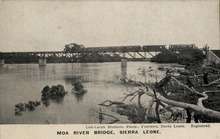
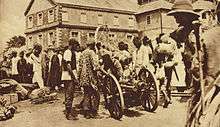
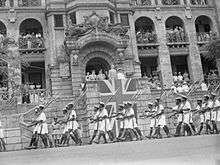
The defeat of the Temne and Mende in the Hut Tax war ended mass resistance to the Protectorate and colonial government, but intermittent rioting and labour unrest continued throughout the colonial period. Riots in 1955 and 1956 involved "many tens of thousands" of Sierra Leonians in the protectorate.[43]
Domestic slavery, which continued to be practised by local African elites, was abolished in 1928.[44] A notable event in 1935 was the granting of a monopoly on mineral mining to the Sierra Leone Selection Trust, run by De Beers. The monopoly was scheduled to last 98 years. Mining of diamonds in the east and other minerals expanded, drawing labourers there from other parts of the country.
In 1924, the UK government divided Sierra Leone into a Colony and a Protectorate, with different political systems constitutionally defined for each. The Colony was Freetown and its coastal area; the Protectorate was defined as the hinterland areas dominated by local chiefs. Antagonism between the two entities escalated to a heated debate in 1947, when proposals were introduced to provide for a single political system for both the Colony and the Protectorate. Most of the proposals came from leaders of the Protectorate, whose population far outnumbered that in the colony. The Krios, led by Isaac Wallace-Johnson, opposed the proposals, as they would have resulted in reducing the political power of the Krios in the Colony.
In 1951, educated protectorate leaders from different groups, including Sir Milton Margai, Lamina Sankoh, Siaka Stevens, Mohamed Sanusi Mustapha, John Karefa-Smart, Kande Bureh, Sir Albert Margai, Amadu Wurie and Sir Banja Tejan-Sie joined together with the powerful paramount chiefs in the protectorate to form the Sierra Leone People's Party or SLPP as the party of the protectorate. The SLPP leadership, led by Sir Milton Margai, negotiated with the British and the educated Krio-dominated colony based in Freetown to achieve independence.[45]
Owing to the astute politics of Milton Margai of the Mende, the educated Protectorate elite was won over to join forces with the paramount chiefs in the face of Krio intransigence. Later, Margai used the same skills to win over opposition leaders and moderate Krio elements to achieve independence from the UK.[46] In November 1951, Margai oversaw the drafting of a new constitution, which united the separate Colonial and Protectorate legislatures and provided a framework for decolonisation.[47] In 1953, Sierra Leone was granted local ministerial powers and Margai was elected Chief Minister of Sierra Leone.[47] The new constitution ensured Sierra Leone a parliamentary system within the Commonwealth of Nations.[47] In May 1957, Sierra Leone held its first parliamentary election. The SLPP, which was then the most popular political party in the colony of Sierra Leone as well as being supported by the powerful paramount chiefs in the provinces, won the most seats in Parliament and Margai was re-elected as Chief Minister by a landslide.
1960 Independence Conference
On 20 April 1960, Milton Margai led a 24-member Sierra Leonean delegation at constitutional conferences that were held with the Government of Queen Elizabeth II and British Colonial Secretary Iain Macleod in negotiations for independence held in London.[48][49]
On the conclusion of talks in London on 4 May 1960, the United Kingdom agreed to grant Sierra Leone Independence on 27 April 1961.[48][49]
Independence (1961) and Margai Administration (1961–1964)
On 27 April 1961, Sir Milton Margai led Sierra Leone to independence from Great Britain and became the country's first Prime Minister. Thousands of Sierra Leoneans took to the streets in celebration. The Dominion of Sierra Leone retained a parliamentary system of government and was a member of the Commonwealth of Nations. The leader of the main opposition All People's Congress (APC), Siaka Stevens, along with Isaac Wallace-Johnson, another outspoken critic of the SLPP government, were arrested and placed under house arrest in Freetown, along with sixteen others charged with disrupting the independence celebration.[50]
In May 1962, Sierra Leone held its first general election as an independent nation. The Sierra Leone People's Party (SLPP) won a plurality of seats in parliament, and Milton Margai was re-elected as prime minister.
Margai was very popular among Sierra Leoneans during his time in power, most known for his self-effacement. He was neither corrupt nor did he make a lavish display of his power or status.[51] He based the government on the rule of law and the separation of powers, with multiparty political institutions and fairly viable representative structures. Margai used his conservative ideology to lead Sierra Leone without much strife. He appointed government officials to represent various ethnic groups. Margai employed a brokerage style of politics, by sharing political power among political parties and interest groups; and with the powerful paramount chiefs in the provinces, most of whom were key allies of his government.
Final years of democracy (1964–1967)
Upon Milton Margai's unexpected death in 1964, his half-brother, Sir Albert Margai, was appointed as Prime Minister by parliament. Sir Albert's leadership was briefly challenged by Foreign Minister John Karefa-Smart, who questioned Sir Albert's succession to the SLPP leadership position. Karefa-Smart led a prominent small minority faction within the SLPP party in opposition of Albert Margai as Prime Minister. However, Karefa-Smart failed to receive strong support within the SLPP and the SLPP dominated members of parliament in his attempt to have Albert Margai stripped of his position as the leader of the SLPP and prime minister of the country. The large majority of SLPP members backed Albert Margai over Karefa-Smart. Soon after Albert Margai was sworn in as Prime Minister, he dismissed several senior government officials who had served under his elder brother Milton's government, viewing them as a threat to his administration, including Karefa-Smart.
Sir Albert resorted to increasingly authoritarian actions in response to protests and enacted several laws against the opposition All People's Congress (APC), whilst attempting to establish a one-party state. Sir Albert was opposed to the colonial legacy of allowing executive powers to the Paramount Chiefs, many of whom had been key allies of his late brother Sir Milton. Accordingly, they began to consider Sir Albert a threat to the ruling houses across the country. Margai appointed many non-Creoles to the country's civil service in Freetown, in an overall diversification of the civil service in the capital, which had been dominated by members of the Creole ethnic group. As a result, Albert Margai became unpopular in the Creole community, many of whom had supported Sir Milton. Margai was accused of favouring members of his own Mende ethnic group for prominent positions.
In 1967, riots broke out in Freetown against Margai's policies; in response he declared a state of emergency across the country. Sir Albert was accused of corruption and of a policy of affirmative action in favour of his own Mende ethnic group.[52] Although possessing the full backing of the country's security forces, he called for free and fair elections.
Military coups (1967–1968)
The APC, with its leader Siaka Stevens, narrowly won a small majority of seats in Parliament over the SLPP in a closely contested 1967 general election. Stevens was sworn in as Prime Minister on 21 March 1967.
Within hours after taking office, Stevens was ousted in a bloodless military coup led by Brigadier General David Lansana, the commander of the Sierra Leone Armed Forces. He was a close ally of Albert Margai, who had appointed him to the position in 1964. Lansana placed Stevens under house arrest in Freetown and insisted that the determination of Prime Minister should await the election of the tribal representatives to the House. Upon his release, Stevens went into exile in Guinea.
On 23 March 1967, a group of military officers in the Sierra Leone Army led by Brigadier General Andrew Juxon-Smith, overrode this action by a coup d'état; they seized control of the government, arresting Lansana, and suspending the constitution. The group set up the National Reformation Council (NRC), with Andrew Juxon-Smith as its chairman and Head of State of the country.[53]
On 18 April 1968 a group of low ranking soldiers in the Sierra Leone Army who called themselves the Anti-Corruption Revolutionary Movement (ACRM), led by Brigadier General John Amadu Bangura, overthrew the NRC junta. The ACRM junta arrested many senior NRC members. They reinstated the constitution and returned power to Stevens, who at last assumed the office of Prime Minister.[54]
One-party state (1968–1991)
Stevens assumed power again in 1968 with a great deal of hope and ambition. Much trust was placed upon him as he championed multi-party politics. Stevens had campaigned on a platform of bringing the tribes together under socialist principles. During his first decade or so in power, Stevens renegotiated some of what he called "useless prefinanced schemes" contracted by his predecessors, both Albert Margai of the SLPP and Juxon-Smith of the NRC. Some of these policies by the SLPP and the NRC were said to have left the country in an economically deprived state.
Stevens reorganised the country's oil refinery, the government-owned Cape Sierra Hotel, and a cement factory.[55] He cancelled Juxon-Smith's construction of a church and mosque on the grounds of Victoria Park (since mid 2017 Freetown Amusement Park). Stevens began efforts that would later bridge the distance between the provinces and the city. Roads and hospitals were constructed in the provinces, and Paramount Chiefs and provincial peoples became a prominent force in Freetown.
Under pressure of several coup attempts, real or perceived, Stevens' rule grew more and more authoritarian, and his relationship with some of his ardent supporters deteriorated. He removed the SLPP party from competitive politics in general elections, some believed, through the use of violence and intimidation. To maintain the support of the military, Stevens retained the popular John Amadu Bangura as the head of the Sierra Leone Armed Forces.
After the return to civilian rule, by-elections were held (beginning in autumn 1968) and an all-APC cabinet was appointed. Calm was not completely restored. In November 1968, unrest in the provinces led Stevens to declare a state of emergency across the country. Many senior officers in the Sierra Leone Army were greatly disappointed with Stevens' policies and his handling of the Sierra Leone Military, but none could confront Stevens. Brigadier General Bangura, who had reinstated Stevens as Prime Minister, was widely considered the only person who could control Stevens. The army was devoted to Bangura, and this made him potentially dangerous to Stevens. In January 1970, Bangura was arrested and charged with conspiracy and plotting to commit a coup against the Stevens government. After a trial that lasted a few months, Bangura was convicted and sentenced to death. On 29 March 1970, Brigadier Bangura was executed by hanging in Freetown.
After the execution of Bangura, a group of soldiers loyal to the executed Brigadier Bangura held a mutiny in the capital Freetown and in some other parts of the country in opposition of Stevens' government. Dozens of soldiers were arrested and convicted by a court martial in Freetown for their participation in the mutiny against president Stevens. Among the soldiers arrested was a little known army Corporal Foday Sankoh, a strong supporter of Bangura. Corporal Sankoh was convicted and jailed for seven years at the Pademba Road Prison in Freetown.
In April 1971, a new republican constitution was adopted under which Stevens became president. In the 1972 by-elections the opposition SLPP complained of intimidation and procedural obstruction by the APC and militia. These problems became so severe that the SLPP boycotted the 1973 general election; as a result the APC won 84 of the 85 elected seats.[56]
An alleged plot to overthrow president Stevens failed in 1974 and its leaders were executed. In mid 1974, Guinean soldiers, requested by Stevens, were in the country to help maintain his hold on power as Stevens was a close ally of then Guinean president Ahmed Sekou Toure. In March 1976, Stevens was elected without opposition for a second five-year term as president. On 19 July 1975, 14 senior army and government officials including David Lansana, former cabinet minister Mohamed Sorie Forna (father of writer Aminatta Forna), Brigadier General Ibrahim Bash Taqi and Lieutenant Habib Lansana Kamara were executed after being convicted of allegedly attempting a coup to topple president Stevens' government.
In 1977, a nationwide student demonstration against the government disrupted Sierra Leone politics. The demonstration was quickly put down by the army and Stevens' own personal Special Security Division (SSD) force, a heavily armed paramilitary force he had created to protect him and to maintain his hold on power.[57] The SSD officers were very loyal to Stevens and were deployed across Sierra Leone to put down any rebellion or protest against Stevens' government. A general election was called later that year in which corruption was again endemic; the APC won 74 seats and the SLPP 15. In 1978, the APC-dominant parliament approved a new constitution making the country a one-party state. The 1978 constitution made the APC the only legal political party in Sierra Leone.[58] This move led to another major demonstration against the government in many parts of the country, but again it was put down by the army and Stevens' SSD forces.
Stevens is generally criticised for dictatorial methods and government corruption, but on a positive note, he kept the country stable and from collapsing into civil war. He built several government institutions that are still in use today. Stevens also reduced ethnic polarisation in government by incorporating members of various ethnic groups into his all-dominant APC government.
Siaka Stevens retired from politics in November 1985 after being in power for eighteen years. The APC named a new presidential candidate to succeed Stevens at their last delegate conference held in Freetown in November 1985. He was Major General Joseph Saidu Momoh, the head of the Republic of Sierra Leone Armed Forces and Stevens' own choice to succeed him. As head of the Sierra Leone Armed Forces, Major General Momoh was very loyal to Stevens, who had appointed him to the position. Like Stevens, Momoh was also a member of the minority Limba ethnic group.
Momoh was elected president as the only contesting candidate, without any opposition, and was sworn in as Sierra Leone's second president on 28 November 1985 in Freetown. A one-party parliamentary election between APC members was held in May 1986. President Momoh appointed his former military colleague and key ally, Major General Mohamed Tarawalie to succeed him as the head of the Sierra Leone Military. Major General Tarawalie was also a strong loyalist and key supporter of president Momoh. President Momoh named James Bambay Kamara as the head of the Sierra Leone Police. Bambay Kamara was a key loyalist and strong supporter of President Momoh. Momoh broke away from former president Siaka Stevens, by integrating the powerful SSD into the Sierra Leone Police as a special paramilitary force of the Sierra Leone Police. Under President Stevens, the SSD had been a powerful personal force used to maintain his hold on power, independent from the Sierra Leone Military and Sierra Leone Police Force. The Sierra Leone Police under Bambay Kamara's leadership, was accused of physical violence, arrest and intimidation against critics of President Momoh's government.
President Momoh's strong links with the army and his verbal attacks on corruption earned him much-needed initial support among Sierra Leoneans. With the lack of new faces in the new APC cabinet under president Momoh and the return of many of the old faces from Stevens' government, criticisms soon arose that Momoh was simply perpetuating the rule of Stevens.
The next couple of years under the Momoh administration were characterised by corruption, which Momoh defused by sacking several senior cabinet ministers. To formalise his war against corruption, President Momoh announced a "Code of Conduct for Political Leaders and Public Servants." After an alleged attempt to overthrow President Momoh in March 1987, more than 60 senior government officials were arrested, including Vice-President Francis Minah, who was removed from office, convicted of plotting the coup, and executed by hanging in 1989 along with 5 others.
Sierra Leone Civil War (1991–2002)
In October 1990, owing to mounting pressure from both within and outside the country for political and economic reform, president Momoh set up a constitutional review commission to assess the 1978 one-party constitution. Based on the commission's recommendations a constitution re-establishing a multi-party system was approved by the exclusive APC Parliament by a 60% majority vote, becoming effective on 1 October 1991. There was great suspicion that president Momoh was not serious about his promise of political reform, as APC rule continued to be increasingly marked by abuses of power.
The brutal civil war that was going on in neighbouring Liberia played a significant role in the outbreak of fighting in Sierra Leone. Charles Taylor – then leader of the National Patriotic Front of Liberia – reportedly helped form the Revolutionary United Front (RUF) under the command of former Sierra Leonean army corporal Foday Saybana Sankoh, an ethnic Temne from Tonkolili District in Northern Sierra Leone. Sankoh was a British trained former army corporal who had also undergone guerrilla training in Libya. Taylor's aim was for the RUF to attack the bases of Nigerian dominated peacekeeping troops in Sierra Leone who were opposed to his rebel movement in Liberia.
On 29 April 1992, a group of young soldiers in the Sierra Leone Army, led by seven army officers — Lieutenant Sahr Sandy, Captain Valentine Strasser, Sergeant Solomon Musa, Captain Komba Mondeh, Lieutenant Tom Nyuma, Captain Julius Maada Bio and Captain Komba Kambo—[60] launched a military coup that sent president Momoh into exile in Guinea, and the young soldiers established the National Provisional Ruling Council (NPRC), with 25-year-old Captain Valentine Strasser as its chairman and Head of State of the country.[61]
Sergeant Solomon Musa, a childhood friend of Strasser, became the deputy chairman and deputy leader of the NPRC junta government. Strasser became the world's youngest Head of State when he seized power just three days after his 25th birthday. The NPRC junta established the National Supreme Council of State as the military highest command and final authority in all matters, and was exclusively made up of the highest ranking NPRC soldiers, included Strasser himself and the original soldiers who toppled president Momoh.[61]
One of the highest ranking soldiers of the NPRC Junta, Lieutenant Sahr Sandy, a trusted ally of Strasser, was assassinated, allegedly by Major S.I.M. Turay, a key loyalist of ousted president Momoh. A heavily armed military manhunt took place across the country to find Lieutenant Sandy's killer. However, the main suspect, Major S.I.M Turay, went into hiding and fled the country to Guinea, fearing for his life. Dozens of soldiers loyal to the ousted president Momoh were arrested, including Colonel Kahota M. Dumbuya and Major Yayah Turay. Lieutenant Sandy was given a state funeral and his funeral prayers service at the cathedral church in Freetown was attended by many high-ranking soldiers of the NPRC junta, including Strasser himself and NPRC deputy leader Sergeant Solomon Musa.
The NPRC Junta immediately suspended the constitution, banned all political parties, limited freedom of speech and freedom of the press and enacted a rule-by-decree policy, in which soldiers were granted unlimited powers of administrative detention without charge or trial, and challenges against such detentions in court were precluded.
The NPRC Junta maintained relations with the Economic Community of West African States (ECOWAS) and strengthened support for Sierra Leone-based ECOMOG troops fighting in Liberia. On 28 December 1992, an alleged coup attempt against the NPRC government of Strasser, aimed at freeing the detained Colonel Yahya Kanu, Colonel Kahota M.S. Dumbuya and former inspector general of police Bambay Kamara, was foiled. Several Junior army officers led by Sergeant Mohamed Lamin Bangura were identified as being behind the coup plot. The coup plot led to the firing squad execution of seventeen soldiers in the Sierra Leone Army including Colonel Kahota M Dumbuya, Major Yayah Kanu and Sergeant Mohamed Lamin Bangura. Several prominent members of the Momoh government who had been in detention at the Pa Demba Road prison, including former inspector general of police Bambay Kamara, were also executed.[62]
On 5 July 1994 the deputy NPRC leader Sergeant Solomon Musa, who was very popular with the general population, particularly in Freetown, was arrested and sent into exile after he was accused of planning a coup to topple Strasser, an accusation Sergeant Musa denied. Strasser replaced Musa as deputy NPRC chairman with Captain Julius Maada Bio, who was instantly promoted by Strasser to Brigadier.
The NPRC proved to be nearly as ineffectual as the Momoh-led APC government in repelling the RUF. More and more of the country fell to RUF fighters, and by 1994 they held much of the diamond-rich Eastern Province and were at the edge of Freetown. In response, the NPRC hired several hundred mercenaries from the private firm Executive Outcomes. Within a month they had driven RUF fighters back to enclaves along Sierra Leone's borders, and cleared the RUF from the Kono diamond-producing areas of Sierra Leone.
With Strasser's two most senior NPRC allies and commanders Lieutenant Sahr Sandy and Lieutenant Solomon Musa no longer around to defend him, Strasser's leadership within the NPRC Supreme Council of State was not considered much stronger. On 16 January 1996, after about four years in power, Strasser was arrested in a palace coup at the Defence Headquarters in Freetown by his fellow NPRC soldiers.[63] Strasser was immediately flown into exile in a military helicopter to Conakry, Guinea.
In his first public broadcast to the nation following the 1996 coup, Brigadier Bio stated that his support for returning Sierra Leone to a democratically elected civilian government and his commitment to ending the civil war were his motivations for the coup.[64] Promises of a return to civilian rule were fulfilled by Bio, who handed power over to Ahmad Tejan Kabbah, of the Sierra Leone People's Party (SLPP), after the conclusion of elections in early 1996. President Kabbah took power with a great promise of ending the civil war. President Kabbah opened dialogue with the RUF and invited RUF leader Foday Sankoh for peace negotiations.
On 25 May 1997, seventeen soldiers in the Sierra Leone army led by Corporal Tamba Gborie, loyal to the detained Major General Johnny Paul Koroma, launched a military coup which sent President Kabbah into exile in Guinea and they established the Armed Forces Revolutionary Council (AFRC). Corporal Gborie quickly went to the Sierra Leone Broadcasting Services headquarters in New England, Freetown to announce the coup to a shocked nation and to alert all soldiers across the country to report for guard duty. The soldiers immediately released Koroma from prison and installed him as their chairman and Head of State.
Koroma suspended the constitution, banned demonstrations, shut down all private radio stations in the country and invited the RUF to join the new junta government, with its leader Foday Sankoh as the Vice-Chairman of the new AFRC-RUF coalition junta government. Within days, Freetown was overwhelmed by the presence of the RUF combatants who came to the city in thousands. The Kamajors, a group of traditional fighters mostly from the Mende ethnic group under the command of deputy Defence Minister Samuel Hinga Norman, remained loyal to President Kabbah and defended the Southern part of Sierra Leone from the soldiers.
Kabbah's government and the end of civil war (2002–2014)
After nine months in office, the junta was overthrown by the Nigerian-led ECOMOG forces, and the democratically elected government of president Kabbah was reinstated in February 1998. On 19 October 1998 24 soldiers in the Sierra Leone army were executed by firing squad after they were convicted in a court martial in Freetown, some for orchestrating the 1997 coup that overthrew President Kabbah and others for failure to reverse the mutiny.[65]
In October 1999, the United Nations agreed to send peacekeepers to help restore order and disarm the rebels. The first of the 6,000-member force began arriving in December, and the UN Security Council voted in February 2000 to increase the force to 11,000, and later to 13,000. But in May, when nearly all Nigerian forces had left and UN forces were trying to disarm the RUF in eastern Sierra Leone, Sankoh's forces clashed with the UN troops, and some 500 peacekeepers were taken hostage as the peace accord effectively collapsed. The hostage crisis resulted in more fighting between the RUF and the government as UN troops launched Operation Khukri to end the siege. The Operation was successful with Indian and British Special Forces being the main contingents.
The situation in the country deteriorated to such an extent that British troops were deployed in Operation Palliser, originally simply to evacuate foreign nationals. However, the British exceeded their original mandate, and took full military action to finally defeat the rebels and restore order. The British were the catalyst for the ceasefire that ended the civil war. Elements of the British Army, together with administrators and politicians, remain in Sierra Leone to this day, helping train the armed forces, improve the infrastructure of the country and administer financial and material aid. Tony Blair, the Prime Minister of Britain at the time of the British intervention, is regarded as a hero by the people of Sierra Leone, many of whom are keen for more British involvement. Sierra Leoneans have been described as "The World's Most Resilient People".[66]
Between 1991 and 2001, about 50,000 people were killed in Sierra Leone's civil war. Hundreds of thousands of people were forced from their homes and many became refugees in Guinea and Liberia. In 2001, UN forces moved into rebel-held areas and began to disarm rebel soldiers. By January 2002, the war was declared over. In May 2002, Kabbah was re-elected president by a landslide. By 2004, the disarmament process was complete. Also in 2004, a UN-backed war crimes court began holding trials of senior leaders from both sides of the war. In December 2005, UN peacekeeping forces pulled out of Sierra Leone.
In August 2007, Sierra Leone held presidential and parliamentary elections. However, no presidential candidate won the 50% plus one vote majority stipulated in the constitution on the first round of voting. A runoff election was held in September 2007, and Ernest Bai Koroma, the candidate of the main opposition APC, was elected president. Koroma was re-elected president for a second (and final) term in November 2012.
Struggle with the Ebola epidemic (2014–2016)
In 2014 an Ebola virus epidemic in Sierra Leone began, which had widespread impact on the country,[67] including forcing Sierra Leone to declare a state of emergency.[68] By the end of 2014 there were nearly 3000 deaths and about 10 thousand cases of the disease in Sierra Leone.[67] The epidemic also led to the Ouse to Ouse Tock in September 2014, a nationwide three-day quarantine.[69] The epidemic occurred as part of the wider Ebola virus epidemic in West Africa. In early August 2014 Sierra Leone cancelled league football (soccer) matches because of the Ebola epidemic.[70] On 16 March 2016, the World Health Organisation declared Sierra Leone to be free from Ebola.[71]
14 August 2017 mudslides
Several mudslides occurred around 6:30 AM on the fourteenth of August 2017 in and near the country's capital Freetown.
2018 general election
In 2018, Sierra Leone held a general election. The presidential election, in which neither candidate reached the required threshold of 55%, went to a second round of voting, in which Julius Maada Bio was elected with 51% of the vote.
Geography and climate
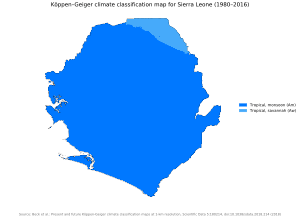
Sierra Leone is located on the southwest coast of West Africa, lying mostly between latitudes 7° and 10°N (a small area is south of 7°), and longitudes 10° and 14°W. The country is bordered by Guinea to the north and east, Liberia to the southeast, and the Atlantic Ocean to the west and southwest.[72]
Sierra Leone has a total area of 71,740 km2 (27,699 sq mi), divided into a land area of 71,620 km2 (27,653 sq mi) and water of 120 km2 (46 sq mi).[73] The country has four distinct geographical regions. In eastern Sierra Leone the plateau is interspersed with high mountains, where Mount Bintumani reaches 1,948 m (6,391 ft), the highest point in the country. The upper part of the drainage basin of the Moa River is located in the south of this region.
The centre of the country is a region of lowland plains, containing forests, bush and farmland,[72] that occupies about 43% of Sierra Leone's land area. The northern section of this has been categorised by the World Wildlife Fund as part of the Guinean forest-savanna mosaic ecoregion, while the south is rain-forested plains and farmland.
In the west, Sierra Leone has some 400 km (249 mi) of Atlantic coastline, giving it both bountiful marine resources and attractive tourist potential. The coast has areas of low-lying Guinean mangroves swamp. The national capital Freetown sits on a coastal peninsula, situated next to the Sierra Leone Harbour, the world's third largest natural harbour.
The climate is tropical, with two seasons determining the agricultural cycle: the rainy season from May to November, and a dry season from December to May, which includes harmattan, when cool, dry winds blow in off the Sahara Desert and the night-time temperature can be as low as 16 °C (60.8 °F). The average temperature is 26 °C (78.8 °F) and varies from around 26 to 36 °C (78.8 to 96.8 °F) during the year.[74][75]
Environment
Human activities claimed to be responsible or contributing to land degradation in Sierra Leone include unsustainable agricultural land use, poor soil and water management practices, deforestation, removal of natural vegetation, fuelwood consumption and to a lesser extent overgrazing and urbanisation.[76]
Deforestation, both for commercial timber and to make room for agriculture, is the major concern and represents an enormous loss of natural economic wealth to the nation.[76] Mining and slash and burn for land conversion – such as cattle grazing – dramatically diminished forested land in Sierra Leone since the 1980s. It is listed among countries of concern for emissions, as having Low Forest Cover with High Rates of Deforestation (LFHD).[77]
There are concerns that heavy logging continues in the Tama-Tonkoli Forest Reserve in the north. Loggers have extended their operations to Nimini, Kono District, Eastern Province; Jui, Western Rural District, Western Area; Loma Mountains National Park, Koinadougu, Northern Province; and with plans to start operations in the Kambui Forest reserve in the Kenema District, Eastern Province.[77]
Overfishing is also an issue in Sierra Leone.
Habitat degradation for the African wild dog, Lycaon pictus, has been increased, such that this canid is deemed to have been extirpated in Sierra Leone.[78]
Until 2002, Sierra Leone lacked a forest management system because of the civil war that caused tens of thousands of deaths. Deforestation rates have increased 7.3% since the end of the civil war.[79] On paper, 55 protected areas covered 4.5% of Sierra Leone as of 2003. The country has 2,090 known species of higher plants, 147 mammals, 626 birds, 67 reptiles, 35 amphibians, and 99 fish species.[79]
The Environmental Justice Foundation has documented how the number of illegal fishing vessels in Sierra Leone's waters has multiplied in recent years. The amount of illegal fishing has significantly depleted fish stocks, depriving local fishing communities of an important resource for survival. The situation is particularly serious as fishing provides the only source of income for many communities in a country still recovering from over a decade of civil war.[80]
In June 2005, the Royal Society for the Protection of Birds (RSPB) and BirdLife International agreed to support a conservation-sustainable development project in the Gola Forest in south eastern Sierra Leone,[81] an important surviving fragment of rainforest in Sierra Leone.
Government and politics
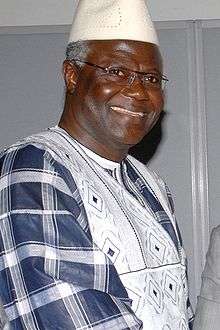
Sierra Leone is a constitutional republic with a directly elected president and a unicameral legislature. The current system of the Government of Sierra Leone is based on the 1991 Sierra Leone Constitution. Sierra Leone has a dominant unitary central government and a weak local government. The executive branch of the Government of Sierra Leone, headed by the president of Sierra Leone has extensive powers and influences. The president is the most powerful government official in Sierra Leone.[82]
Within the confines of the 1991 Constitution, supreme legislative powers are vested in Parliament, which is the law making body of the nation. Supreme executive authority rests in the president and members of his cabinet and judicial power with the judiciary of which the Chief Justice of Sierra Leone is the head.
The president is the head of state, the head of government and the commander-in-chief of the Sierra Leone Armed Forces. The president appoints and heads a cabinet of ministers, which must be approved by the Parliament. The president is elected by popular vote to a maximum of two five-year terms. The president is the highest and most influential position within the government of Sierra Leone.
To be elected president of Sierra Leone, a candidate must gain at least 55% of the vote. If no candidate gets 55%, there is a second-round runoff between the top two candidates.
The current president of Sierra Leone is former military junta leader Julius Maada Bio.[83] Bio defeated Samura Kamara of the ruling All People's Congress in the country's tightly contested 2018 presidential election. Bio replaced outgoing President Ernest Bai Koroma after Bio was sworn into office on 4 April 2018 by Chief Justice Abdulai Cham. Bio is the leader of the Sierra Leone People's Party, the current ruling party in Sierra Leone.
Next to the president is the Vice-president, who is the second-highest ranking government official in the executive branch of the Sierra Leone Government. As designated by the Sierra Leone Constitution, the vice-president is to become the new president of Sierra Leone upon the death, resignation, or removal of the President.
Parliament
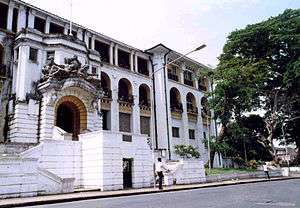
The Parliament of Sierra Leone is unicameral, with 124 seats. Each of the country's fourteen districts is represented in parliament. 112 members are elected concurrently with the presidential elections; the other 12 seats are filled by paramount chiefs from each of the country's 12 administrative districts. The Sierra Leone parliament is led by the Speaker of Parliament, who is the overall leader of Parliament and is directly elected by sitting members of parliament. The current speaker of the Sierra Leone parliament is Sheku Badara Bashiru Dumbuya, who was elected by members of parliament on 21 January 2014.
The current members of Parliament of Sierra Leone were elected in the 2012 Sierra Leone parliamentary election. The All People's Congress (APC) currently has 70 of the 112 elected parliamentary seats and the Sierra Leone People's Party (SLPP) has 42 of the elected 132 parliamentary seats. Sierra Leone's two most dominant parties, the APC and the SLPP, collectively won every elected seats in Parliament in the 2012 Sierra Leone parliamentary election. To be qualified as Member of Parliament, the person must be a citizen of Sierra Leone, must be at least 21 years old, must be able to speak, read and write the English language with a degree of proficiency to enable him to actively take part in proceedings in Parliament; and must not have any criminal conviction.[82]
Since independence in 1961, Sierra Leone's politics has been dominated by two major political parties: the SLPP and the ruling APC. Other minor political parties have also existed but with no significant support.[84]
Judiciary
The judicial power of Sierra Leone is vested in the judiciary, headed by the Chief Justice of Sierra Leone and comprising the Supreme Court of Sierra Leone, which is the highest court in the country and its ruling therefore cannot be appealed. Other courts include the High Court of Justice, the Court of Appeal, the magistrate courts, and traditional courts in rural villages. The president appoints and parliament approves Justices for the three courts. The Judiciary have jurisdiction in all civil and criminal matters throughout the country. The current acting Chief Justice of Sierra Leone is Valicious Thomas.[85]
Foreign relations
The Sierra Leonean Ministry of Foreign Affairs and International Cooperation is responsible for foreign policy of Sierra Leone. Sierra Leone has diplomatic relations that include China, Russia,[86] Libya, Iran, and Cuba.
Sierra Leone has good relations with the West, including the United States, and has maintained historical ties with the United Kingdom and other former British colonies through membership in the Commonwealth of Nations.[87] The United Kingdom has played a major role in providing aid to the former colony, together with administrative help and military training since intervening to end the Civil War in 2000.
Former President Siaka Stevens' government had sought closer relations with other West African countries under the Economic Community of West African States (ECOWAS) a policy continued by the current government. Sierra Leone, along with Liberia and Guinea, form the Mano River Union (MRU). It is primarily designed to implement development projects and promote regional economic integration between the three countries.[88]
Sierra Leone is also a member of the United Nations and its specialised agencies, the African Union, the African Development Bank (AFDB), the Organisation of Islamic Cooperation (OIC), and the Non-Aligned Movement (NAM).[89] Sierra Leone is a member of the International Criminal Court with a Bilateral Immunity Agreement of protection for the US military (as covered under Article 98).
Administrative divisions
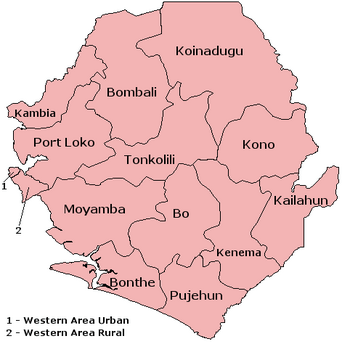
The Republic of Sierra Leone is composed of four regions: the Northern Province, Southern Province, the Eastern Province, and the Western Area. Three provinces are further divided into 12 districts; and the Western Area is divided into two districts.
The provincial districts are divided into 149 chiefdoms, which have traditionally been led by paramount chiefs, recognised by the British administration in 1896 at the time of organising the Protectorate of Sierra Leone. The Paramount Chiefs are very influential, particularly in villages and small rural towns.[90] Each chiefdom has ruling families that were recognised at that time; the Tribal Authority, made up of local notables, elects the paramount chief from the ruling families.[90] Typically, chiefs have the power to "raise taxes, control the judicial system, and allocate land, the most important resource in rural areas."[91]
Within the context of local governance, the districts are governed as localities. Each has a directly elected local district council to exercise authority and carry out functions at a local level.[92][93] In total, there are 19 local councils: 13 district councils, one for each of the 12 districts and one for the Western Area Rural, and six municipalities also have elected local councils. The six municipalities include Freetown, which functions as the local government for the Western Area Urban District, and Bo, Bonthe, Kenema, Koidu, and Makeni.[92][94][95]
While the district councils are under the oversight of their respective provincial administrations, the municipalities are directly overseen by the Ministry of Local Government & Community Development and thus administratively independent of district and provincial administrations.
| District | Area km2 | Province | Population (2004 census)[96] | Population (2015 census)[97] | |
|---|---|---|---|---|---|
| Bombali District | Makeni | 7,985 | Northern Province | 408,390 | 606,183[98] |
| Koinadugu District | Kabala | 12,121 | 265,758 | 408,097[99] | |
| Port Loko District | Port Loko | 5,719 | 453,746 | 614,063[99] | |
| Tonkolili District | Magburaka | 7,003 | 347,197 | 530,776[100] | |
| Kambia District | Kambia | 3,108 | 270,462 | 343,686[101] | |
| Kenema District | Kenema | 6,053 | Eastern Province | 497,948 | 609,873[102] |
| Kono District | Koidu Town | 5,641 | 335,401 | 505,767[103] | |
| Kailahun District | Kailahun | 3,859 | 358,190 | 525,372[103] | |
| Bo District | Bo | 5,219 | Southern Province | 463,668 | 574,201[104] |
| Bonthe District | Mattru Jong | 3,468 | 139,687 | 200,730[105] | |
| Pujehun District | Pujehun | 4,105 | 228,392 | 345,577 | |
| Moyamba District | Moyamba | 6,902 | 260,910 | 318,064 | |
| Western Area Urban District | Freetown | 13 | Western Area | 772,873 | 1,050,301 |
| Western Area Rural District | Waterloo | 544 | 174,249 | 442,951 |
Military
The Military of Sierra Leone, officially the Republic of Sierra Leone Armed Forces (RSLAF), are the unified armed forces of Sierra Leone responsible for the territorial security of Sierra Leone's border and defending the national interests of Sierra Leone within the framework of its international obligations. The armed forces were formed after independence in 1961, on the basis of elements of the former British Royal West African Frontier Force present in the country. The Sierra Leone Armed Forces consists of around 15,500 personnel, comprising the largest Sierra Leone Army,[106] the Sierra Leone Navy and the Sierra Leone Air Wing.[107]
The President of Sierra Leone is the Commander in Chief of the military, with the Minister of Defence responsible for defence policy and the formulation of the armed forces. The current Sierra Leonean Defence Minister is retired Major Alfred Paolo Conteh. The Military of Sierra Leone also has a Chief of the Defence Staff who is a uniformed military official responsible for the administration and the operational control of the Sierra Leone military.[108] Brigadier General Alfred Nelson-Williams who was appointed by president Koroma succeeded the retired Major General Edward Sam M'boma on 12 September 2008 as the Chief of Defence Staff of the Military.[109]
Before Sierra Leone gained independence in 1961, the military was known as the Royal Sierra Leone Military Force. The military seized control in 1968, bringing the National Reformation Council into power. On 19 April 1971, when Sierra Leone became a republic, the Royal Sierra Leone Military Forces were renamed the Republic of Sierra Leone Military Force (RSLMF).[110] The RSLMF remained a single-service organisation until 1979, when the Sierra Leone Navy was established. In 1995 Defence Headquarters was established, and the Sierra Leone Air Wing formed. The RSLMF was renamed as the Armed Forces of the Republic of Sierra Leone (AFRSL).
Law enforcement
Law enforcement in Sierra Leone is primarily the responsibility of the Sierra Leone Police (SLP), which is accountable to the Minister of Internal Affairs (appointed by the president). Sierra Leone Police was established by the British colony in 1894; it is one of the oldest police forces in West Africa. It works to prevent crime, protect life and property, detect and prosecute offenders, maintain public order, ensure safety and security, and enhance access to justice. The Sierra Leone Police is headed by the Inspector General of Police, the professional head of the Sierra Leone Police force, who is appointed by the President of Sierra Leone.
Each one of Sierra Leone's 14 districts is headed by a district police commissioner who is the professional head of their respective district. These Police Commissioners report directly to the Inspector General of Police at the Sierra Leone Police headquarters in Freetown. The current Inspector General of Police is Brima Acha Kamara, who was appointed to the position by former president Ahmad Tejan Kabbah.
Human rights
Male same-sex sexual activity is illegal under Section 61 of the Offences against the Person Act 1861, and imprisonment for life is possible.[111][112]
Economy
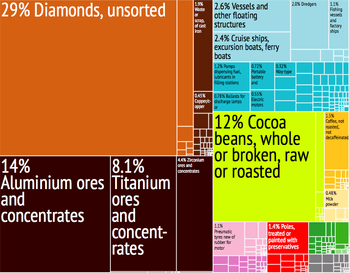
By the 1990s economic activity was declining and economic infrastructure had become seriously degraded. Over the next decade much of the formal economy was destroyed in the country's civil war. Since the end of hostilities in January 2002, massive infusions of outside assistance have helped Sierra Leone begin to recover.[113]
Much of the recovery will depend on the success of the government's efforts to limit corruption by officials, which many feel was the chief cause for the civil war. A key indicator of success will be the effectiveness of government management of its diamond sector.
There is high unemployment, particularly among the youth and ex-combatants. Authorities have been slow to implement reforms in the civil service, and the pace of the privatisation programme is also slackening and donors have urged its advancement.
The currency is the leone. The central bank is the Bank of Sierra Leone. Sierra Leone operates a floating exchange rate system, and foreign currencies can be exchanged at any of the commercial banks, recognised foreign exchange bureaux and most hotels. Credit card use is limited in Sierra Leone, though they may be used at some hotels and restaurants. There are a few internationally linked automated teller machines that accept Visa cards in Freetown operated by ProCredit Bank.
Agriculture
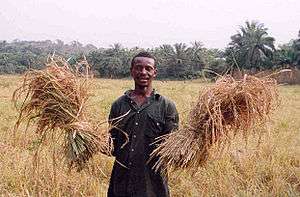
Two-thirds of the population of Sierra Leone are directly involved in subsistence agriculture.[114] Agriculture accounted for 58 per cent of gross domestic product (GDP) in 2007.[115]
Agriculture is the largest employer with 80 per cent of the population working in the sector.[116] Rice is the most important staple crop in Sierra Leone with 85 per cent of farmers cultivating rice during the rainy season[117] and an annual consumption of 76 kg per person.[118]
Mining
Rich in minerals, Sierra Leone has relied on mining, especially diamonds, for its economic base. The country is among the top ten diamond producing nations. Mineral exports remain the main currency earner. Sierra Leone is a major producer of gem-quality diamonds. Though rich in diamonds, it has historically struggled to manage their exploitation and export.
Sierra Leone is known for its blood diamonds that were mined and sold to diamond conglomerates during the civil war, to buy the weapons that fuelled its atrocities.[119] In the 1970s and early 1980s, economic growth rate slowed because of a decline in the mining sector and increasing corruption among government officials.
| Rank | Sector | Percentage of GDP |
|---|---|---|
| 1 | Agriculture | 58.5 |
| 2 | Other services | 10.4 |
| 3 | Trade and tourism | 9.5 |
| 4 | Wholesale and retail trade | 9.0 |
| 5 | Mining and quarrying | 4.5 |
| 6 | Government Services | 4.0 |
| 7 | Manufacturing and handicrafts | 2.0 |
| 8 | Construction | 1.7 |
| 9 | Electricity and water | 0.4 |
Annual production of Sierra Leone's diamond estimates range between US$250 million–$300 million. Some of that is smuggled, where it is possibly used for money laundering or financing illicit activities. Formal exports have dramatically improved since the civil war, with efforts to improve the management of them having some success. In October 2000, a UN-approved certification system for exporting diamonds from the country was put in place and led to a dramatic increase in legal exports. In 2001, the government created a mining community development fund (DACDF), which returns a portion of diamond export taxes to diamond mining communities. The fund was created to raise local communities' stake in the legal diamond trade.
Sierra Leone has one of the world's largest deposits of rutile, a titanium ore used as paint pigment and welding rod coatings.
Transport infrastructure

There are a number of systems of transport in Sierra Leone, which has a road, air and water infrastructure, including a network of highways and several airports. There are 11,300 kilometres (7,000 miles) of highways in Sierra Leone, of which 904 km (562 mi)[73] are paved (about 8% of the roads). Sierra Leone's highways are linked to Conakry, Guinea, and Monrovia, Liberia.
Sierra Leone has the largest natural harbour on the African continent, allowing international shipping through the Queen Elizabeth II Quay in the Cline Town area of eastern Freetown or through Government Wharf in central Freetown. There are 800 km (497 mi) of waterways in Sierra Leone, of which 600 km (373 mi) are navigable year-round. Major port cities are Bonthe, Freetown, Sherbro Island and Pepel.
There are ten regional airports in Sierra Leone, and one international airport. The Lungi International Airport located in the coastal town of Lungi in Northern Sierra Leone is the primary airport for domestic and international travel to or from Sierra Leone. Passengers cross the river to Aberdeen Heliports in Freetown by hovercraft, ferry or a helicopter. Helicopters are also available from the airport to other major cities in the country. The airport has paved runways longer than 3,047 metres (9,997 feet). The other airports have unpaved runways, and seven have runways from 914 to 1,523 metres (2,999 to 4,997 feet) long; the remaining two have shorter runways.
Sierra Leone appears on the EU list of prohibited countries with regard to the certification of airlines. This means that no airline registered in Sierra Leone may operate services of any kind within the European Union. This is due to substandard safety standards.[120]
As of May 2014 the country's only international airport had regularly scheduled direct flights to London, Paris, Brussels and most major cities in West Africa.
In September 2014 there were many Districts with travel restrictions including Kailahun, Kenema, Bombali, Tonkolili, and Port Loko because of Ebola.[121]
Energy in Sierra Leone
Overview
As of 2016, about 12% of the population of Sierra Leone had access to electricity. Of the 12%, 10% was in the capital Freetown, and the remaining 90% of the country used 2% of the nation's electricity.[122] The majority of the population relies on biomass fuels for their daily survival, with firewood and coal used most prevalently.[123] The burning of these sources has been reported to have adverse health effects on women and children.[123] A 2012 study was done on the correlation between Acute Respiratory Infection (ARI), and burning biomass fuels in the home. The results were that 64% of children were diagnosed with ARI where firewood stoves were used, and 44% where charcoal stoves were used.[123] The use of coal and firewood has also posed environmental concerns as they are both conflict with the push for more sustainable sources energy.[124] As a result, the commercialisation of firewood and coal has been a point of contention with aid donors and government agencies such as the Ministry of Energy and Water Resources and the Forestry Division.[124] There have been strong pushes for both solar and hydropower to become the dominant sources of energy in Sierra Leone because of the UN's Sustainable Development Goals, particularly goal number seven (affordable and clean energy). Sierra Leone's tropical climate, heavy annual rainfall, and abundance of rivers give it potential to realistically pursue more solar and hydropower alternatives.[125]
Solar energy
In conjunction with the UK's Department for International Development (DFID), Sierra Leone has set the goal to provide solar power to all of its citizens by 2025.[126] This overarching goal has been broken down into smaller goals as well. The first of these goals is to provide solar power to at least 50,000 homes in 2016, the second is 250,000 homes by 2017, and finally to provide power to 1,000,000 people by 2020.[126] This initiative falls under the Energy Africa access campaign which seeks to provide electricity to 14 different African countries by 2030.[122] Previous to this compact agreement, Sierra Leone's private sector for solar energy was weak, as it provided energy to less than 5% of the target population.[122] Part of the reason for this was due to the import duties and taxes and the lack of quality control.[122] In order to ensure that the Energy Africa goal is met, Sierra Leone has agreed to remove its import duties and Value Added Tax (VAT) on certified solar products.[126] This change will attempt to encourage foreign investment while providing affordable, quality solar products to its citizens. It is estimated that there will be a 30% to 40% cost reduction on solar products with the lack of duties and taxes.[122]
Hydroelectric power
As of 2012, Sierra Leone has 3 main hydroelectric plants. The first is the Guma plant which was decommissioned in 1982, the second is the Dodo Plant which is located in the Eastern Province, and finally the Bumbuna plant.[125] There is also potential for several new hydroelectric plants to be opened on the Sewa River, Pampana River, Seli River, Moa River, and Little Scarcies.[125] Amongst all these projects, both finished and potential, the Bumbuna dam still remains the largest of the hydroelectric projects in Sierra Leone.[125] It is located near the Seli River and Freetown and was estimated to produce about 50 megawatts of electricity.[127] There were plans to increase its capacity 400 megawatts by 2017 which would cost around $750 million.[128] It has been projected that the Bumbuna dam could potentially reduce the amount of spending on foreign fuel and save the country at least $2 million a month.[129] In the past this project received its funding of over $200 million from a combination of the World Bank, the African Development Bank, and the Italian company Salini Impregilo.[127]
Society
Demographics
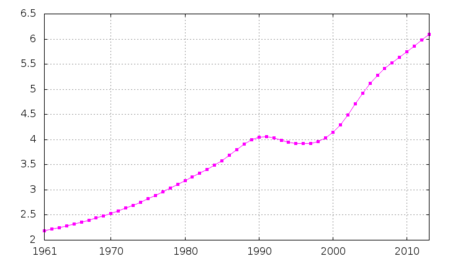
In 2013 Sierra Leone had an officially projected population of 6,190,280[130] and a growth rate of 2.216% a year.[73] The country's population is mostly young, with an estimated 41.7% under 15, and rural, with an estimated 62% of people living outside the cities.[73] As a result of migration to cities, the population is becoming more urban with an estimated rate of urbanisation growth of 2.9% a year.[73][131]
Population density varies greatly within Sierra Leone. The Western Area Urban District, including Freetown, the capital and largest city, has a population density of 1,224 persons per square km. The largest district geographically, Koinadugu, has a much lower density of 21.4 persons per square km.[131]
English is the official language,[132] spoken at schools, government administration and in the media. Krio (derived from English and several indigenous African languages, and the language of the Sierra Leone Krio people) is the most widely spoken language in virtually all parts of Sierra Leone. As the Krio language is spoken by 90% of the country's population,[73][133] it unites all the different ethnic groups, especially in their trade and interaction with each other.[134]
According to the World Refugee Survey 2008, published by the US Committee for Refugees and Immigrants, Sierra Leone had a population of 8,700 refugees and asylum seekers at the end of 2007. Nearly 20,000 Liberian refugees voluntarily returned to Liberia over the course of 2007. Of the refugees remaining in Sierra Leone, nearly all were Liberian.[135]
The populations quoted above for the five largest cities are from the 2004 census. The figure for Freetown is for the Western Urban Area (Greater Freetown). Other figures are estimates from the source cited. Different sources give different estimates. Some claim that Magburaka should be included in the above list, but there is considerable difference among sources. One source estimates the population at 14,915,[137] whilst another puts it as high as 85,313.[138] "Pandebu-Tokpombu" is presumably the extended town of Torgbonbu, which had a population of 10,716 in the 2004 census. "Gbendembu" had a larger population of 12,139 in that census. In the 2004 census, Waterloo had a population of 34,079.
Religion
Sierra Leone is officially a secular state, although Islam and Christianity are the two main religions in the country. The constitution of Sierra Leone provides for freedom of religion and the Sierra Leone Government generally protects it. The Sierra Leonean Government is constitutionally forbidden from establishing a state religion, though Muslim and Christian prayers are usually held in the country at the beginning of major political occasions, including presidential inaugurations and the official opening of the new session of Parliament.
Surveys of the religious make up of Sierra Leone vary widely, though Muslims make up the majority of the population. Based on 2015 estimates of the population of Sierra Leone, 77% of the population are Muslims, 22% are Christians, and 1% practice African traditional religion.
According to a 2010 estimates by the Pew Research Center[139] 78% of Sierra Leone's population are Muslims (mostly Sunni), 20.9 are Christians (mostly Protestants) and 1% belong to a traditional African religion or other beliefs. The Inter-Religious Council of Sierra Leone estimated that 77% of Sierra Leone's population are Muslims, 21% are Christians, and 2% are followers of traditional African religion.[140] Most of Sierra Leone's ethnic groups are Muslim majority, including the country's two largest ethnic groups: the Mende and Temne.
Sierra Leone is regarded as one of the most religiously tolerant countries in the world.[141][142] Muslims and Christians collaborate and interact with each other peacefully. Religious violence is very rare in the country. Even during the Sierra Leonean Civil War people were never targeted because of their religion.
The country is home to the Sierra Leone Inter-Religious Council, which is made up of both Christian and Muslim religious leaders to promote peace and tolerance throughout the country.[143][144][145] The Islamic holidays of Eid al-Fitr, Eid al-Adha and Maulid-un-Nabi (Birthday of the Islamic prophet Muhammad) are observed as national holidays in Sierra Leone. The Christian holidays of Christmas, Boxing Day, Good Friday and Easter are also national holidays in Sierra Leone. In politics the overwhelming majority of Sierra Leoneans vote for a candidate without regard of the candidate being a Muslim or a Christian. All of Sierra Leone"s Heads of State have been Christians except Ahmad Tejan Kabbah, who was a Muslim.
The overwhelming majority of Sierra Leonean Muslims, are adherent to the Sunni tradition of Islam in practice. Most of the Mosques and Islamic schools across Sierra Leone are based in Sunni Islam. Ahmadiyya Muslims make up about 10% of the country's Muslim population. Sierra Leone has a vibrant Ahmaddiya Muslim population, especially in the southern city of Bo, that is home to a large Ahmadiyya Muslim population. There are five hundred Ahmaddiyya Mosque across Sierra Leone.[146] Shia Islam does not have strong present in Sierra Leone, and there are virtually no Shia Muslims in the country. Most of Sierra Leonean Muslims of the Sunni and Ahmadiyya sect generally pray together in the same Mosque.[147][148] The vast majority of Sierra Leonean Muslims are adherent to the Maliki school of Sunni Islam. The Maliki school is by far the largest and most dominant Islamic school of jurisprudence across Sierra Leone. Many Ahmadiyya Muslims in Sierra Leone also follow the Maliki Jurisprudence.
The Sierra Leone Islamic Supreme Council, is the highest Islamic religious organisation in Sierra Leone and is made up of the country's Imams, Islamic scholars, and other Islamic clerics across the country. Sheikh Muhammad Taha Jalloh is the president of the Sierra Leone Supreme Islamic Council.[149] The United Council of Imams, is a very influential Islamic religious body in Sierra Leone, that is made up of all imams of mosques throughout Sierra Leone. The president of the United Council of Imam is Sheikh Alhaji Muhammad Habib Sheriff.*Sierra Leone Imams present new president to Hon. Minister responsible for Religious Affairs* – Cocorioko. The two largest mosques in Sierra Leone are the Freetown Central Mosque and the Ghadafi Central Mosque (built by former Libyan dictator Muammar Gaddafi), both located in the capital Freetown.
The large majority of Sierra Leonean Christians are Protestant, of which the largest groups are the Wesleyan _ Methodists.[150][151][152][153][154] Other Christian Protestant denominations with significant presence in the country include Presbyterians,[155] Baptists,[156] Seventh-day Adventists[157] Anglicans,[158] Lutherans,[159][160] and Pentecostals.[161] The Council of Churches is the Christian religious organisation that is made up of Protestant churches across Sierra Leone. Recently there has been an increase of Pentecostal churches, especially in Freetown.
In September 2017, a Sierra Leone-based Nigerian Pentecostal Christian pastor name Victor Ajisafe was arrested by the Sierra Leone Police and held in jail after he preached an extreme religious intolerance and a fanatical hate speech against Islam and Sierra Leonean Muslims in particular at his church sermon in the capital Freetown. Ajisafe was apparently angry and jealous after a Zimbabwean internationally renowned Muslim cleric Mufti Menk visited Sierra Leone and had approximately over one hundred thousand people in and outside the national stadium in Freetown to listen to his Islamic sermon in his visit to Sierra Leone on 21 to 23 September 2017.[162] Many Christian organisations in Sierra Leone, including the Council of Churches condemned Ajisafe's sermon against Islam and Muslims. Ajisafe"s church was temporarily shut down by the Sierra Leone government and his church licence was temporarily suspended too. The incident brought religious tension in Sierra Leone, in a country known for its very high level of religious tolerance, as many Sierra Leonean Muslims at home and abroad were extremely angry, many called for Ajisafe to be deported back to his home country of Nigeria. The pastor while in Sierra Leone police custody apologised to Sierra Leonean Muslims and to the government of Sierra Leone. After several days in jail, Ajisafe was released, his church licence was given back to him, and his church was later reopened under strict government condition during several months of probation.
Non-denominational Protestants form a significant minority of Sierra Leone's Christian population.[163] Catholics are the largest group of non-Protestant Christians in Sierra Leone, forming about 8% of Sierra Leone's population and 26% of the Christian population in Sierra Leone.[164] The Jehovah’s Witnesses[165] and The Church of Jesus Christ of Latter-day Saints[166][167] are the two most prominent non Trinitarian Christians in Sierra Leone, and they form a small but significant minority of the Christian population in Sierra Leone. A small community of Orthodox Christians resides in the capital Freetown.[168]
Ethnic groups
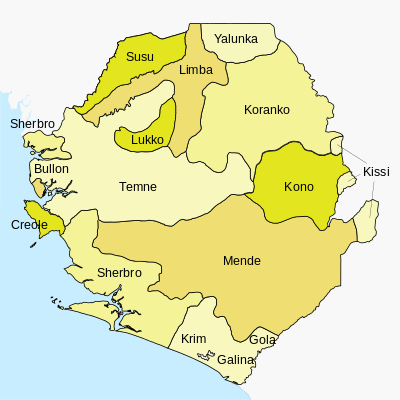
| Ethnic groups of Sierra Leone[3] | |
| Mende | 32.2% |
| Temne | 31.6% |
| Limba | 8.4% |
| Kono | 5.2% |
| Koranko | 4.5% |
| Fula | 3.8% |
| Susu | 2.9% |
| Kissi | 2.5% |
| Loko | 2.4% |
| Mandingo | 2.3% |
| Sherbro | 1.9% |
| Creole | 1.3% |
| Yalunka | 0.7% |
| Krim | 0.2% |
| Vai | 0.0% |
Sierra Leone is home to about sixteen ethnic groups, each with its own language. The largest and most influential are the Temne at about 32.2% and the Mende at about 31.6%. The Temne predominate in the Northern Sierra Leone and the some areas around the capital of Sierra Leone. The Mende predominate in South-Eastern Sierra Leone (with the exception of Kono District).
The vast majority of Temne are Muslims at over 85%; and with a significant Christian minority at about 10%. The Mende are also Muslim majority at about 70%, though with a large Christian minority at about 30%. Sierra Leone's national politics centres on the competition between the north-west, dominated by the Temne, and the south-east dominated by the Mende. The vast majority of the Mende support the Sierra Leone People's Party (SLPP); while the majority of the Temne support the All People's Congress (APC).[169]
The Mende, who are believed to be descendants of the Mane, originally occupied the Liberian hinterland. They began moving into Sierra Leone slowly and peacefully in the eighteenth century. The Temne are said to migrated from Futa Jallon, which is in present-day Guinea.
The third-largest ethnic group are the Limba at about 8.4% of the population. The Limba are native people of Sierra Leone. They have no tradition of origin, and it is believed that they have lived in Sierra Leone since before the European encounter. The Limba are primarily found in Northern Sierra Leone, particularly in Bombali, Kambia and Koinadugu District. The Limba are about 60% Christian and 40% Muslims. The Limba are close political allies of the neighbouring Temne.
Since Independence, the Limba have traditionally been very influential in Sierra Leone's politics, along with the Mende. The vast majority of Limba support the All People's Congress (APC) political party. Sierra Leone's first and second presidents, Siaka Stevens and Joseph Saidu Momoh, respectively, were both ethnic Limba. Sierra Leone's current Defense Minister Alfred Paolo Conteh is an ethnic Limba.
One of the biggest minority ethnic groups are the Fula at around 3.8% of the population. Descendants of seventeenth- and eighteenth-century Fula migrant settlers from the Fouta Djalon region of Guinea, they live primarily in the northeast and the western area of Sierra Leone. The Fula are virtually all Muslims at over 99%. The Fula are primarily traders, and many live in middle-class homes. Because of their trading, the Fulas are found in nearly all parts of the country.
The other ethnic groups are the Mandingo (also known as Mandinka). They are descendants of traders from Guinea who migrated to Sierra Leone during the late nineteenth to mid-twentieth centuries. The Mandika are predominantly found in the east and the northern part of the country. They predominate in the large towns, most notably Karina, in Bombali District in the north; Kabala and Falaba in Koinadugu District in the north; and Yengema, Kono District in the east of the country. Like the Fula, the Mandinka are virtually all Muslims at over 99℅. Sierra Leone's third president Ahmad Tejan Kabbah, and Sierra Leone's first Vice-President Sorie Ibrahim Koroma were both ethnic Mandingo.
Next in proportion are the Kono, who live primarily in Kono District in Eastern Sierra Leone. The Kono are descendants of migrants from Guinea; today their workers are known primarily as diamond miners. The majority of the Kono ethnic group are Christians, though with an influential Muslim minority. Sierra Leone's former Vice-President Alhaji Samuel Sam-Sumana is an ethnic Kono.
The small but significant Krio people (descendants of freed African American, West Indian and Liberated African slaves who settled in Freetown between 1787 and about 1885) make up about 3% of the population. They primarily occupy the capital city of Freetown and its surrounding Western Area. Krio culture reflects the Western culture and ideals within which many of their ancestors originated – they also had close ties with British officials and colonial administration during years of development.
The Krio have traditionally dominated Sierra Leone's judiciary and Freetown's elected city council. One of the first ethnic groups to become educated according to Western traditions, they have traditionally been appointed to positions in the civil service, beginning during the colonial years. They continue to be influential in the civil service. The vast majority of Krios are Christians at about 90%, though with a small but significant Muslim minority at 10% known locally as Oku.
Other minority ethnic groups are the Kuranko, who are related to the Mandingo, and are largely Muslims. The Kuranko are believed to have begun arriving in Sierra Leone from Guinea in about 1600 and settled in the north, particularly in Koinadugu District. The Kuranko are primarily farmers; leaders among them have traditionally held several senior positions in the Military. The current Governor of the Bank of Sierra Leone Kaifala Marah is an ethnic Kuranko. The Kuranko are largely Muslim majority.
The Loko in the north are native people of Sierra Leone, believed to have lived in Sierra Leone since the time of European encounter. Like the neighbouring Temne, the Loko are Muslim majority. The Susu and their related Yalunka The Susu and their related Yalunka are traders; both groups are primarily found in the far north in Kambia and Koinadugu District close to the border with Guinea. The Susu and Yalunka kingdom was established in the early 5th 7th century before Mali empire, which was extended from Mali, Senegal, Guinea Bissau, Guinea Conakry to the northern part of Sierra Leone. They are the original owners of the Futa Djallon region covered by a vars land area both the Susu and Yalunka people are descendants of the Mande people. They are virtually all Muslims. The Yalunka, also spelled Jallonke, Yalonga, Djallonké, Djallonka or Dialonké, are a Mande people who have lived in the Djallon, a mountainous region in Sierra Leone, Mali, Senegal, Guinea Bissau and Guinea Conakry West Africa over 520 years ago. The name Yalunka literally means "inhabitants of the Jallon (mountains)." Manga Sewa was born in Falaba, Solima chiefdom, in the Northern Province of British Sierra Leone to Yalunka parents. His father was a Yalunka paramount chief of Solima, a prosperous chieftaincy. Its capital, Falaba, was on the rich trading routes leading to the coast. Manga Sewa's father had a number of wives and dozens of children.are traders; both groups are primarily found in the far north in Kambia and Koinadugu District close to the border with Guinea. The Susu and Yalunka are both descendants of migrants from Guinea; and they both are virtually all Muslims at over 99%.
The Kissi live further inland in South-Eastern Sierra Leone. They predominate in the large town of Koindu and its surrounding areas in Kailahun District. The vast majority of Kissi are Christians. The much smaller Vai and Kru peoples are primarily found in Kailahun and Pujehun Districts near the border with Liberia. The Kru predominate in the Kroubay neighbourhood in the capital Freetown. The Vai are largely Muslim majority at about 90%, while the Kru are virtually all Christians at over 99%.
On the coast in Bonthe District in the south are the Sherbro. Native to Sierra Leone, they have occupied Sherbro Island since it was founded. The Sherbro are primarily fisherman and farmers, and they are predominantly found in Bonthe District. The Sherbro are virtually all Christians, and their paramount chiefs had a history of intermarriage with British colonists and traders.
A small number of Sierra Leoneans are of partial or full Lebanese ancestry, descendants of traders who first came to the nation in the 19th century. They are locally known as Sierra Leonean-Lebanese. The Sierra Leonean-Lebanese community are primarily traders and they mostly live in middle-class households in the urban areas, primarily in Freetown, Bo, Kenema, Koidu Town and Makeni.
Gender equality
Household
Although women account for about 50 per cent of the population in Sierra Leone, only 28 per cent are household heads.[170] As in the rest of the countries, education is a key factor in succeeding in aspects such as a well-paid job and covering the needs of a house. Rural areas are the most common to lack access to education having only male-headed four per cent ahead of females with basic education and 1.2 per cent more at post-graduate level.[170]
In Sierra Leone, normally, men are automatically positioned as household heads; and their status does not change if their marital status changes over time.[170] However, female household does change depending on their marital status. A woman can be the head of the house only if she remains single for the rest of her life. But if a woman gets married, she will not be entitled as the head of the house any more.[170] Females can take over the household head if they become widowed or divorced.[170]
In the labour field, it is expected that the household will financially provide the needs of the family. However, females face gender discrimination making them the target of lower incomes and financial struggle.[170] In numbers, females present a lower per cent (6.3) versus males (15.2) when it comes to be paid employees.[170]
War
Children who have been forced to be part of a war have experienced severe mental and emotional damage in Sierra Leone. However, the damage and way to deal with the effects of war depends on the gender of the kids. Both genders experienced and were involved in high levels of violence. Females, experiencing higher levels of rapes, presented greater signs of depression and anxiety.[171] Males, on the other hand, presented higher levels of anxiety and hostility.[171] Males also showed to be more vulnerable to depression after losing a care giver.[171]
Epidemics (Ebola)
With women being more than half the population of Sierra Leone, they contribute in great part to the country's economy and society.[172] Sierra Leonean women in care-giving positions were particularly susceptible to the disease because of the potential close contact with infected individuals. If and when the infected person died, women were in charge of preparing the funeral, which involves touching the infected body which in turn gave women a high risk of becoming infected.[172] The vulnerability in infected women with Ebola grows when health institutions cannot provide a high quality service because they are full or do not have the right equipment to treat the patients.[172]
Gender-Based Violence
In certain societies such as Sierra Leone, the lack of social and economic support for women makes them more vulnerable, making them the target of gender violence. By managing to repress women, men possess greater power and become the decision-maker.[173] The method to implement gender-based violence can vary; it can be sexual, physical, verbal, economical, or emotional.[173] Violence does not respect factors such as age, socio-economical position, or education.[173] Denouncing violence is hard for most women due to the honour and reputation of their family name.[173] A victim, who suffers from violence, begins to lose self-confidence due to fear of reporting the aggressor or exposing family problems.[173] This is why a woman who suffers from physical violence prefers not to attend with a specialist to heal her wounds.[173] In some other cases, when females dare to denounce the crime, the system is very corrupt that authorities involved accept bribes from the victimiser.[173]
Female Economy
Small female-operated business not only could contribute to Sierra Leone's economy, it could also help women to become independent in several ways. However, women face discrimination when it comes to obtain financial, social, and cultural help to start a business.[174] It is difficult to avoid the economic paralysis in Sierra Leone given that more than half of the population in the country is women.[174] Due to the lack of access to basic education, women are the least prepared when in comes to process business licence, register the name or contracting.[174] Not having the capital to start a new business is the biggest barrier for women.[174] With the lack of technology, mostly in all Sierra Leone, it is hard to help a business to function.[174]
Education
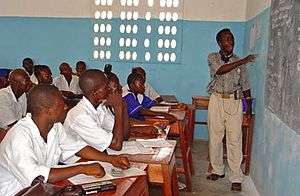
Education in Sierra Leone is legally required for all children for six years at primary level (Class P1-P6) and three years in junior secondary education,[175] but a shortage of schools and teachers has made implementation impossible.[59] Two thirds of the adult population of the country are illiterate.[176]
The Sierra Leone Civil War resulted in the destruction of 1,270 primary schools, and in 2001, 67% of all school-age children were out of school.[59] The situation has improved considerably since then with primary school enrolment doubling between 2001 and 2005 and the reconstruction of many schools since the end of the war.[177] Students at primary schools are usually 6 to 12 years old, and in secondary schools 13 to 18. Primary education is free and compulsory in government-sponsored public schools.
The country has three universities: Fourah Bay College, founded in 1827 (the oldest university in West Africa),[178] University of Makeni (established initially in September 2005 as The Fatima Institute, the college was granted university status in August 2009, and assumed the name University of Makeni, or UNIMAK), and Njala University, primarily located in Bo District. Njala University was established as the Njala Agricultural Experimental Station in 1910 and became a university in 2005.[179] Teacher training colleges and religious seminaries are found in many parts of the country. Israel grants scholarships to Sierra Leone students as part of its international development cooperation program.[180]
Health
The CIA estimated that the average life expectancy in Sierra Leone was 57.39 years.[181]
The prevalence of HIV/AIDS in the population is 1.6%, higher than the world average of 1% but lower than the average of 6.1% across Sub-Saharan Africa.[182]
Medical care is not readily accessible, with doctors and hospitals out of reach for many villagers. While free health care may be provided in some villages, the medical staff is poorly paid and sometimes charge for their services, taking advantage of the fact that the villagers are not aware of their right to free medical care.[183]
A dialysis machine, the first of its kind in the country, was donated by Israel.[180]
According to an Overseas Development Institute report, private health expenditure accounts for 85.7% of total spending on health.[184]
Emergency medical response
Having had no formal emergency medical services previously, the First Responder Coalition of Sierra Leone (FRCSL) was formed in June 2019 in Makeni to facilitate the development of emergency first responder programs nationwide.[185] The founding members of the Coalition included the Sierra Leone Red Cross Society (the first chairing organisation), LFR International (proposed the formation), the University of Makeni, Agency for Rural Community Transformation, and the Holy Spirit Hospital.[185] The establishment of the Coalition was concurrent with the declaration by the 72nd World Health Assembly that emergency care systems are essential to universal health coverage.[186] Between June and July 2019, the FRCSL trained 1,000 community members from Makeni to be first responders and equipped each trainee with a first aid kit.[187]
Endemic and infectious diseases
Sierra Leone suffers from epidemic outbreaks of diseases, including yellow fever, cholera, lassa fever and meningitis.[188][189] Yellow fever and malaria are endemic to Sierra Leone.[189]
Maternal and child health
According to 2010 estimates, Sierra Leone has the 5th highest maternal mortality rate in the world.[190] According to a 2013 UNICEF report,[191] 88% of women in Sierra Leone have undergone female genital mutilation. As of 2014, Sierra Leone was estimated as having the 11th highest infant mortality rate in the world.[192]
One of the consequences women in Sierra Leone face after a prolonged and obstructed labour which would have required a c-section is obstetric fistula. This condition often drives women into poverty and isolation.[193]
The AWC- Aberdeen Women's Centre in Freetown, the second busiest hospital in Sierra Leone, delivering up to 3000 babies each year.[194] The centre provides free surgery for women suffering from this condition.
The centre provides a variety of maternal and child health services and is supported by not for profit organisations such as Freedom from Fistula,[195] The Aminata Maternal Foundation,[196] and UNFPA.[197]
Mental health
Mental healthcare in Sierra Leone is almost non-existent. Many sufferers try to cure themselves with the help of traditional healers.[198] During the Civil War (1991–2002), many soldiers took part in atrocities and many children were forced to fight. This left them traumatised, with an estimated 400,000 people (by 2009) being mentally ill. Thousands of former child soldiers have fallen into substance abuse as they try to blunt their memories.[199]
Potable water supply
Water supply in Sierra Leone is characterised by limited access to safe drinking water. Despite efforts by the government and numerous non-governmental organisations, access has not much improved since the end of the Sierra Leone Civil War in 2002, stagnating at about 50% and even declining in rural areas.[200] It is hoped that a new dam in Orugu, for which China committed financing in 2009, will alleviate water scarcity.[201]
According to a national survey carried out in 2006, 84% of the urban population and 32% of the rural population had access to an improved water source. Those with access in rural areas were served almost exclusively by protected wells. The 68% of the rural population without access to an improved water source relied on surface water (50%), unprotected wells (9%) and unprotected springs (9%). Only 20% of the urban population and 1% of the rural population had access to piped drinking water in their home. Compared to the 2000 survey access has increased in urban areas, but has declined in rural areas, possibly because facilities have broken down because of a lack of maintenance.[200][202]
With a new decentralisation policy, embodied in the Local Government Act of 2004, responsibility for water supply in areas outside the capital was passed from the central government to local councils. In Freetown the Guma Valley Water Company remains in charge of water supply.
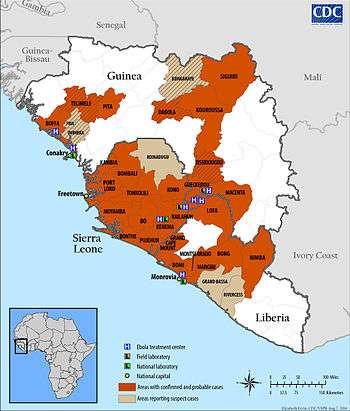
2014 Ebola outbreak
Ebola is prevalent in Africa where social and economic inequalities are common. The central African countries are the most prevalent of EVD; like Democratic Republic of Congo, Sudan, Uganda, and Gabon[203]
In 2014 there was an outbreak of the Ebola virus in West Africa. As of 19 October 2014, there had been 3,706 cases of Ebola in Sierra Leone, and 1,259 deaths, including that of the leading physician trying to control the outbreak, Sheik Umar Khan.[204][205] In early August 2014 Guinea closed its borders to Sierra Leone to help contain the spreading of the virus, which originated in Guinea, as more new cases of the disease were being reported in Sierra Leone than in Guinea. Aside from the human cost, the outbreak was severely eroding the economy. By September 2014, with the closure of borders, the cancellation of airline flights, the evacuation of foreign workers and a collapse of cross-border trade, the national deficit of Sierra Leone and other affected countries was widening to the point where the IMF was considering expanding its financial support.[206]
Culture
Polygamy
37 per cent of married women in Sierra Leone were in polygamous marriages in 2008.[207]
Food and customs
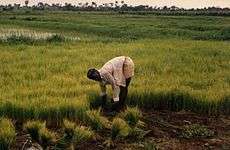
Rice is the staple food of Sierra Leone and is consumed at virtually every meal daily. The rice is prepared in numerous ways, and topped with a variety of sauces made from some of Sierra Leone's favourite toppings, including potato leaves, cassava leaves, crain crain, okra soup, fried fish and groundnut stew.[208]
Along the streets of towns and cities across Sierra Leone one can find foods consisting of fruit, vegetables and snacks such as fresh mangoes, oranges, pineapple, fried plantains, ginger beer, fried potato, fried cassava with pepper sauce; small bags of popcorn or peanuts, bread, roasted corn, or skewers of grilled meat or shrimp.
Poyo is a popular Sierra Leonean drink. It is a sweet, lightly fermented palm wine,[209] and is found in bars in towns and villages across the country. Poyo bars are areas of lively informal debate about politics, football, basketball, entertainment and other issues.
Media
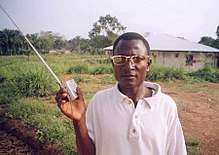
Media in Sierra Leone began with the introduction of the first printing press in Africa at the start of the 19th century. A strong free journalistic tradition developed with the creation of a number of newspapers. In the 1860s, the country became a journalist hub for Africa, with professionals travelling to the country from across the continent. At the end of the 19th century, the industry went into decline, and when radio was introduced in the 1930s, it became the primary communication media in the country.
The Sierra Leone Broadcasting Service (SLBS) was created by the colonial government in 1934 making it the earliest English language radio broadcaster service in West Africa. The service began broadcasting television in 1963, with coverage extended to all the districts in the country in 1978. In April 2010, the SLBS merged with the United Nations peacekeeping radio station in Sierra Leone to form the Sierra Leone Broadcasting Corporation,[210][211] the government-owned current national broadcaster in Sierra Leone.
The Sierra Leone constitution guarantees freedom of speech, and freedom of the press; however, the government maintains strong control of media, and at times restricts these rights in practice.[212][213][214][215][216][217] Some subjects are seen as taboo by society and members of the political elite; imprisonment and violence have been used by the political establishment against journalists.[218][219]
Under legislation enacted in 1980, all newspapers must register with the Ministry of Information and pay sizeable registration fees. The Criminal Libel Law, including Seditious Libel Law of 1965, is used to control what is published in the media.[219]
In 2006, President Ahmad Tejan Kabbah committed to reforming the laws governing the press and media to create a freer system for journalists to work in.[219] As of 2013 Sierra Leone is ranked 61st (up two slots from 63rd in 2012) out of 179 countries on Reporters Without Borders' Press Freedom Index.[220]
Print media is not widely read in Sierra Leone, especially outside Freetown and other major cities, partially due to the low levels of literacy in the country.[221] In 2007 there were 15 daily newspapers in the country, as well as those published weekly.[222] Among newspaper readership, young people are likely to read newspapers weekly and older people daily. The majority of newspapers are privately run and are often critical of the government. The standard of print journalism tends to be low owing to lack of training, and people trust the information published in newspapers less than that found on the radio.[221]
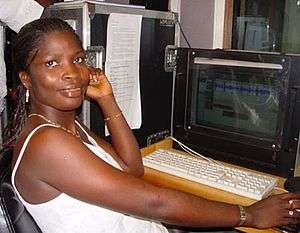
Radio is the most-popular and most-trusted media in Sierra Leone, with 85% of people having access to a radio and 72% of people in the country listening to the radio daily.[221] These levels do vary between areas of the country, with the Western Area having the highest levels and Kailahun the lowest. Stations mainly consist of local commercial stations with a limited broadcast range, combined with a few stations with national coverage – Capital Radio Sierra Leone being the largest of the commercial stations.
The United Nations Mission in Sierra Leone (UNIOSIL) ran one of the most popular stations in the country, broadcasting programs in a range of languages. The UN mission were restructured in 2008 and it was decided that the UN Radio would be merged with SLBS to form the new Sierra Leone Broadcasting Corporation (SLBC). This merger eventually happened in 2011 after the necessary legislation was enacted. SLBC transmits radio on FM and has two television services, one of which is uplinked by satellite for international consumption. FM relays of BBC World Service (in Freetown, Bo, Kenema and Makeni), Radio France Internationale (Freetown only) and Voice of America (Freetown only) are also broadcast.
Outside the capital Freetown and other major cities, television is not watched by a great many people, although Bo, Kenema and Makeni are served by their own relays of the main SLBC service. There are three free terrestrial television stations in Sierra Leone, one run by the government SLBC and the other two are private stations in Freetown, Star TV which is run by the owner of the Standard Times newspaper and AYV - Africa Young Voices. There are a number of religious funded TV stations that operate intermittently. Two other commercial TV operators (ABC and AIT) closed after they were not profitable. In 2007, a pay-per-view service was also introduced by GTV as part of a pan-African television service in addition to the nine-year-old sub-Saharan Digital satellite television service (DStv) originating from Multichoice Africa in South Africa. GTV subsequently went out of business, leaving DStv as the only provider of subscription satellite television in the country. A number of organisations planned to operate digital terrestrial subscription TV services, with Multichoice's Go TV having built infrastructure ahead of getting a licence and ultimately failing to get a licence. ITV and SATCON are currently operational.
Internet access in Sierra Leone has been sparse but is on the increase, especially since the introduction of 3G/4G cellular phone services across the country. There are several main internet service providers (ISPs) operating in the country. Freetown has internet cafés and other businesses offering internet access. Problems experienced with access to the Internet include an intermittent electricity supply and a slow connection speed in the country outside Freetown.
Arts
The arts in Sierra Leone are a mixture of tradition and hybrid African and western styles.[223][224][225]
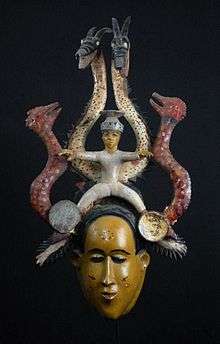 Odelay mask by Temne people. Brooklyn Museum.
Odelay mask by Temne people. Brooklyn Museum.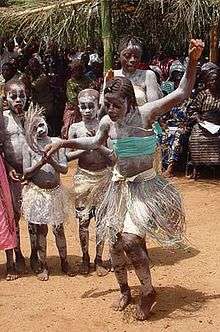 The Koindu dance
The Koindu dance
Sports
Association football is by far the most popular sport in Sierra Leone. Children, youth and adult are frequently seen playing street football across Sierra Leone. There are organised youth and adult football tournaments across the country, and there are various primary and secondary schools with football teams across Sierra Leone.
The Sierra Leone national football team, popularly known as the Leone Stars, represents the country in international competitions. It has never qualified for the FIFA World Cup but participated in the 1994 and 1996 African Cup of Nations. When the national football team, the Leone Stars, have a match, Sierra Leoneans across the country come together united in support of the national team and people rush to their local radio and television stations to follow the live match. The country's national television network, The Sierra Leone Broadcasting Corporation (SLBC) broadcasts the national football team live match, along with many local radio stations across the country.
When the Leone Stars win an important match, many youth across the county rush to the street to celebrate. Many of the Sierra Leone national team footballers play for teams based in Europe although virtually all of them started professional football in the Sierra Leone National Premier League. Many of the national team footballers are celebrities across Sierra Leone and they are often well known by the general population. Some of Sierra Leonean international footballers include Mohamed Kallon, Mohamed Bangura, Rodney Strasser, Kei Kamara, Ibrahim Teteh Bangura, Mustapha Dumbuya, Christian Caulker, Alhassan Bangura, Sheriff Suma, Mohamed Kamara, Umaru Bangura and Julius Gibrilla Woobay.
The Sierra Leone National Premier League is the top professional football league in Sierra Leone and is controlled by the Sierra Leone Football Association. Fourteen clubs from across the country compete in the Sierra Leone Premier League. The two biggest and most successful football clubs are East End Lions and Mighty Blackpool. East End Lions and Mighty Blackpool have an intense rivalry and when they play each other the national stadium in Freetown is often sold out and supporters of both clubs often clash with each other before and after the game. There is a huge police presence inside and outside the national stadium during a match between the two great rivals to prevent a clash. Many Sierra Leonean youth follow the local football league.
Many Sierra Leonean youth, children and adults follow the major football leagues in Europe, particularly the English Premier League, Italian Serie A, Spanish La Liga, German Bundesliga and French Ligue 1.
The Sierra Leone cricket team represents Sierra Leone in international cricket competitions, and is among the best in West Africa. It became an affiliate member of the International Cricket Council in 2002. It made its international debut at the 2004 African Affiliates Championship, where it finished last of eight teams. But at the equivalent tournament in 2006, Division Three of the African region of the World Cricket League, it finished as runner-up to Mozambique, and just missed a promotion to Division Two.
In 2009, the Sierra Leone Under-19 team finished second in the African Under-19 Championship in Zambia, thus qualifying for the Under-19 World Cup qualifying tournament with nine other teams.[226] However, the team was unable to obtain Canadian visas to play in the tournament, which was held in Toronto.[227]
Basketball is not a very popular sport in Sierra Leone. The Sierra Leone national basketball team represents Sierra Leone in international men's basketball competitions and is controlled by the Sierra Leone Basketball Federation.
The National Basketball Association (NBA) is popular among a small portion of the youth population. NBA superstars LeBron James, Kobe Bryant and Kevin Durant are popular among Sierra Leone's youthful population. Former NBA stars, in particular Michael Jordan, Shaquille O'Neal, Allen Iverson and Magic Johnson are popular in the country. Michael Jordan, in particular, is the most famous basketball player in the country and he is very popular among the general population. Current NBA player Victor Oladipo is of Sierra Leonean descent, as his father is a native of Sierra Leone.[228]
Although tennis is not very popular in the country, up-and-coming American player Frances Tiafoe is the son of two Sierra Leoneans who emigrated to the United States.
Sierra Leone is the first African country to join the International Floorball Federation.
See also
- Index of Sierra Leone–related articles
- Outline of Sierra Leone
- 2014 Ebola virus epidemic in Sierra Leone
References
- "Religions in Sierra Leone | PEW-GRF".
- Thomas, Abdul Rashid (22 December 2018). "Sierra Leone parliament approves new Chief Justice". Sierra Leone Telegraph.
- "Sierra Leone 2015 Population and Housing Census National Analytical Report" (PDF). Statistics Sierra Leone. Retrieved 28 March 2020.
- "Sierra Leone". International Monetary Fund. Retrieved 18 April 2013.
- "GINI index (World Bank estimate) - Sierra Leone". World Bank. Retrieved 22 March 2020.
- "Human Development Report 2019" (PDF). United Nations Development Programme. 10 December 2019. Retrieved 10 December 2019.
- Wells, John C. (2008), Longman Pronunciation Dictionary (3rd ed.), Longman, ISBN 9781405881180
- "Sierra Leone". Merriam-Webster Dictionary. Retrieved 22 April 2019.
- Salone Definition
- Encarta Encyclopedia. Sierra Leone (country). Archived from the original on 28 February 2008. Retrieved 19 February 2008.
- "National Electoral Commission – Press Release" (PDF). 6 September 2017. Archived from the original (PDF) on 14 November 2017. Retrieved 1 February 2018.
- "Sierra Leone unveils new geographical map". Africa Review. Archived from the original on 21 February 2018. Retrieved 1 February 2018.
- "Sierra Leone 2015 Population and Housing Census" (PDF). Statistics Sierra Leone.
- "All things happily to all men". The Economist. 31 May 2014.
- Batty, Fodei J. (2010). What Role for Ethnicity? Political Behavior and Mobilization in Post-Conflict Sierra Leone and Liberia (Ph.D.). Western Michigan University.
- "Sierra Leone Population below poverty line (%)". Indexmundi.com. 30 June 2015. Retrieved 5 July 2018.
- https://reignministries.org/5-things-know-sierra-leone/ 5 Thing to Know About Sierra Leone
- "Houses at Sierra-Leone". The Wesleyan Juvenile Offering: A Miscellany of Missionary Information for Young Persons. X: 55. May 1853. Retrieved 29 February 2016.
- Countries and Their Cultures. "Culture of Sierra Leone". Retrieved 22 February 2008.
- Encyclopædia Britannica. "Sierra Leone History". Retrieved 19 February 2008.
- Encyclopedia of the Nations. "Sierra Leone – History". Retrieved 22 February 2008.
- Christopher Fyfe, "Weighing the Probabilities", Review: Landlords and Strangers: Ecology, Society and Trade in Western Africa, 1000–1630, By George E. Brooks. Boulder: Westview Press, 1994. (ISBN 0-8133-1263-9)
- Utting (1931), p. 33.
- Utting (1931), p. 8
- Kingfisher Geography encyclopedia. ISBN 1-85613-582-9. p. 180
- "Pedro da çintra did not name Sierra Leone: An Exploration into available evidence". Sierra Leone Concord Times. 22 June 2017. Retrieved 26 May 2017.
- LeVert, Suzanne (2006). Cultures of the World: Sierra Leone. Marshall Cavendish. p. 22. ISBN 978-0-7614-2334-8.
- Sibthorpe, A. B. C. (1970). The History of Sierra Leone. Routledge. p. 7. ISBN 978-0-7146-1769-5.
- National Maritime Museum (20 August 2015). "Sir John Hawkins". Archived from the original on 16 May 2011. Retrieved 9 December 2008.
- Cassandra Pybus, Epic Journeys of Freedom: Runaway Slaves of the American Revolution and Their Global Quest for Liberty, (Beacon Press, Boston, 2006); Graham Russell Hodges, Susan Hawkes Cook, Alan Edward Brown (eds), The Black Loyalist Directory: African Americans in Exile After the American Revolution (subscription required)
- Pham, John-Peter (2005). Child Soldiers, Adult Interests: The Global Dimensions of the Sierra Leonean Tragedy. Nova Publishers. pp. 4–8. ISBN 978-1-59454-671-6. Retrieved 17 June 2014.
- Michael Sivapragasam, Why Did Black Londoners not join the Sierra Leone Resettlement Scheme 1783–1815? (London: Open University, 2013).
- Gilbert, Alan. Black Patriots and Loyalists: Fighting for Emancipation in the War for Independence. University of Chicago 2012, p. 229
- Fyfe, Christopher (1992). Our Children Free and Happy: Letters from Black Settlers in Africa in the 1790s. Edinburgh University Press.
- "Sierra Leone's struggle for progress". The Economist. 11 December 2008. Retrieved 22 August 2010.
- Simon Schama, Rough Crossings (London: 2005), pp. 380–383.
- Harris, Sheldon H. (1972): Paul Cuffe: Black America and the African Return, New York: Simon and Schuster, pp. 32–33, especially note 15 on p. 140.
- Schwarz, Suzanne (5 January 2013). "Reconstructing the Life Histories of Enslaved Africans: Sierra Leone, c. 1808–19".
- Schwartz, Suzanne (2012). "Reconstructing the Life Histories of Liberated Africans: Sierra Leone in the Early Nineteenth Century". History in Africa.
- Harris, David (2012) Civil War and Democracy in West Africa: Conflict Resolution, Elections and Justice in Sierra Leone and Liberia, I.B. Tauris. p. 40
- Abraham, Arthur (1974). "Bai Bureh, The British, and the Hut Tax War". The International Journal of African Historical Studies. 7 (1): 99–106. doi:10.2307/216556. ISSN 0361-7882. JSTOR 216556.
- History, Sierra-leone.org, Retrieved 17 January 2007.
- Killson, Martin (1966) Political Change in a West African State: A Study of the Modernization Process in Sierra Leone, Cambridge, Massachusetts, USA, pp. 60; also pp. 106, 107, 110, 111, 186–188 on other riots and strikes.
- The Committee Office, House of Commons (6 March 2006). "House of Commons – International Development – Memoranda". Publications.parliament.uk. Retrieved 17 June 2014.
- "Sierra Leone Web - Sierra Leonean Heroes - Achievement of Independence". www.sierra-leone.org.
- "How Independence Was Won". Newafricanmagazine.com. Archived from the original on 29 October 2013. Retrieved 19 March 2014.
- Advocate Nations of Africa: Sierra Leone Archived 5 December 2014 at the Wayback Machine
- Murtala Mohammed Kamara (28 February 2011). "Sierra Leone was ripe for Independence: Exclusive interview with Reginald Boltman". News.sl. Archived from the original on 26 November 2013. Retrieved 17 June 2014.
- Momoh, John (4 May 2011). "Sierra Leone: Viewpoint – Celebrating a New Nation!". allAfrica.com. Retrieved 20 May 2012.
- "BBC On This Day | 27 | 1961: Sierra Leone wins independence". BBC News. 27 April 1961. Retrieved 20 May 2012.
- "Sierra Leone Web - Sierra Leonean Heroes - Achievement of Independence". www.sierra-leone.org. Retrieved 28 November 2018.
- Pham, John-Peter (2005). Child soldiers, adult interests: the global dimensions of the Sierra Leonean tragedy. Nova Publishers. pp. 33–35. ISBN 978-1-59454-671-6. Retrieved 17 June 2014.
- "History of Sierra Leone". Worldrover.com. Retrieved 20 May 2012.
- Gberie, Lansana (2005). A dirty war in West Africa: the RUF and the destruction of Sierra Leone. C. Hurst & Co. Publishers. pp. 26–27. ISBN 978-1-85065-742-2. Retrieved 17 June 2014.
- David Harris. Sierra Leone: A Political History., pp. 67-70 New York: Oxford University Press, 2014. ISBN 9780199361762. $30.00
- Rotberg, Robert I. (2003). State failure and state weakness in a time of terror. Brookings Institution Press. p. 80. ISBN 978-0-8157-7574-4. Retrieved 17 June 2014.
- Politicized security forces or tribalized national politics; which is which? Archived 1 September 2012 at the Wayback Machine. Newstime Africa. Retrieved on 26 February 2013.
- Gberie, Lansana (1998). War and state collapse: The case of Sierra Leone (M.A. thesis) Wilfrid Laurier University
- "Sierra Leone". 2001 Findings on the Worst Forms of Child Labor. Bureau of International Labor Affairs, U.S. Department of Labor. 2002. Archived from the original on 2 November 2013. This article incorporates text from this source, which is in the public domain.
- "NPRC's Komba Kambo Speaks After Eleven Years Of Silence!: Sierra Leone News". News.sl. Archived from the original on 22 February 2014. Retrieved 17 June 2014.
- "SIERRA LEONE NOW: Attempts To Launder Maada Bio's Battered Image Fail... We Were Not Supreme Council Members – Civilians In NPRC Deny Involvement In Atrocities". Salonenow.blogspot.com. Retrieved 20 March 2014.
- "Standard Times Press Sierra Leone's NPRC's Ruthlessness No Death Certificates For 29 Sierra Leoneans". Standardtimespress.org. 23 June 2010. Retrieved 20 May 2012.
- "FSL Vol 2 No 1". Focus-on-sierra-leone.co.uk. Archived from the original on 28 September 2013. Retrieved 23 September 2013.
- "How Sierra Leone fell into the hands of young soldiers". Thefreelibrary.com. Retrieved 20 May 2012.
- Document – Sierra Leone: Imminent execution / death penalty / legal concern |Amnesty International . Amnesty.org (1998). Retrieved on 26 February 2013.
- Bah, M. (1998). The Worlds Most Resilient People. London: Alpha.
- Sierra Leone. Internationalsos.com. Retrieved on 24 February 2017.
- "Sierra Leone country profile". BBC News. 4 January 2017. Retrieved 21 February 2017.
- "Sierra Leone launches three-day, door-to-door Ebola prevention campaign". UNICEF. Retrieved 24 September 2014.
- "Sierra Leone cancels all soccer matches over Ebola outbreak". NY Daily News. Retrieved 7 October 2014.
- Amt, Auswärtiges. "Auswärtiges Amt – Sierra Leone: Reise- und Sicherheitshinweise". Auswärtiges Amt DE (in German). Retrieved 16 March 2018.
- LeVert, Suzanne (2006). Cultures of the World: Sierra Leone. Marshall Cavendish. p. 7. ISBN 978-0-7614-2334-8.
- "Sierra Leone". The World Factbook. CIA. Retrieved 15 September 2011.
- Blinker, Linda (September 2006). Country Environment Profile (CEP) Sierra Leone. Freetown, Sierra Leone: Consortium Parsons Brinckerhoff. p. 12. Archived from the original on 27 September 2013. Retrieved 2 July 2013.
- LeVert, Suzanne (2006). Cultures of the World: Sierra Leone. Marshall Cavendish. pp. 8–9. ISBN 978-0-7614-2334-8.
- UNCCD (2004). "National Report on the Implementation of the United Nations Convention to Combat Desertification (UNCCD): Sierra Leone" (PDF). p. 39. Archived from the original (PDF) on 18 February 2012. Retrieved 24 November 2011.
- Angelsen, Arild; et al. (2009). "Reducing Emissions from Deforestation and Forest Degradation (REDD): An Options Assessment Report" (PDF). Meridian Institute for the Government of Norway. pp. 75–77. Retrieved 24 November 2011.
- Hogan, C. Michael (2009). Painted Hunting Dog: Lycaon pictus Archived 9 December 2010 at the Wayback Machine. GlobalTwitcher.com.
- Butler, Rhett (2005). Sierra Leone: Environmental Profile, mongabay.com
- "Sierra Leone". Environmental Justice Foundation. 17 September 2009. Archived from the original on 10 October 2008.
- BBC News, Sierra Leone sets up forest park, 10 December 2007
- Hanatu Kabbah (November 2006). Sierra Leone Legal System and Legal Research. nyulawglobal.org
- Adebayo, Bukola. "Sierra Leone declares former junta head president". CNN. Retrieved 5 April 2018.
- "Sierra Leone National Election Commission Bulletin". September–December 2011. Retrieved 25 February 2012.
- http://www.newctzen.com/index.php/11-news/2289-acting-chief-justice-appeals-to-colleagues
- Ambassade de la Fédération de Russie en République de Guinée. "Russia and Sierra Leone diplomatic relations". mid.ru. Archived from the original on 16 August 2017. Retrieved 2 May 2017.
- "Background Note: Sierra Leone". U.S. Department of State. October 2008. Retrieved 7 October 2008.
- "Welcome to the Mano River Union Website". Mano River Union. 2006. Archived from the original on 6 July 2008. Retrieved 7 October 2008.
- "Ministry of Foreign Affairs and International Relations". Sierra Leone Encyclopedia. 2007. Archived from the original on 23 February 2009. Retrieved 7 October 2008.
- Tristan Reed and James A. Robinson, The Chiefdoms of Sierra Leone, Scholar, Harvard University, 15 July 2013, accessed 30 April 2014
- Daron Acemoglu, Tristan Reed. and James A. Robinson. "Chiefs: Economic Development and Elite Control of Civil Society in Sierra Leone" Archived 5 March 2016 at the Wayback Machine, Stanford University, 29 August 2013, accessed 30 April 2014
- Renner-Thomas, Ade (2010). Land Tenure in Sierra Leone: The Law, Dualism and the Making of a Land Policy. AuthorHouse. pp. 6–7. ISBN 978-1-4490-5866-1. Retrieved 17 June 2014.
- "ActionAid launches Perception survey as new local councils struggle to survive". ActionAid. Retrieved 26 February 2011.
- "Sierra Leone". Commonwealth Local Government Forum. Retrieved 12 January 2018.
- "Sierra Leone Human Development Report 2007 – Empowering Local Government for Sustainable Development and Poverty Reduction – The District Focus Approach to Development" (PDF). United Nations Development Programme. Retrieved 12 January 2018.
- "Final Results 2004 population and housing census" (PDF). Statistics Sierra Leone. p. 3. Retrieved 17 June 2014.
- "Provisional Results" (PDF). Sierra Leone 2015 Population and Housing Census. Statistics Sierra Leone. March 2016.
- "Bombali – profile of geographical entity including name variants". World Gazetteer. Archived from the original on 11 January 2012. Retrieved 20 May 2012.
- "Port Loko". World-gazetteer.com. Archived from the original on 11 January 2012. Retrieved 20 May 2012.
- "Tonkolili – profile of geographical entity including name variants". World Gazetteer. Archived from the original on 25 March 2012. Retrieved 20 May 2012.
- "Kambia – profile of geographical entity including name variants". World Gazetteer. Archived from the original on 11 January 2012. Retrieved 20 May 2012.
- "Kenema – profile of geographical entity including name variants". World Gazetteer. Archived from the original on 11 January 2012. Retrieved 20 May 2012.
- "Kailahun – profile of geographical entity including name variants". World Gazetteer. Archived from the original on 11 January 2012. Retrieved 20 May 2012.
- "Bo – profile of geographical entity including name variants". World Gazetteer. Archived from the original on 7 April 2012. Retrieved 20 May 2012.
- "Bonthe". World-gazetteer.com. Archived from the original on 23 May 2012. Retrieved 20 May 2012.
- Armed forces (Sierra Leone) Jane's Sentinel Security Assessments, June 2008
- "Summary (Sierra Leone) – Jane's World Air Forces". Janes.com. 30 July 2010. Retrieved 22 August 2010.
- Turay, Aruna (26 March 2009). "In Sierra Leone, Army Chief of Defence Staff Commends Troops". News.sl. Archived from the original on 27 March 2012. Retrieved 20 May 2012.
- New Vision, Freetown, 15 September 2008
- "Partners: Sierra Leone Armed Forces". Daco-sl.org. Archived from the original on 11 January 2010. Retrieved 20 May 2012.
- Lucas Paoli Itaborahy, ed. (May 2012). "State Sponsored Homophobia: A world survey of laws criminalising same-sex sexual acts between consenting adults" (PDF). The International Lesbian, Gay, Bisexual, Trans and Intersex Association. p. 35. Archived from the original (PDF) on 11 June 2012.
- Avery, Daniel (4 April 2019). "71 Countries Where Homosexuality is Illegal". Newsweek.
- "Economic Methodology: Paradox of Ceteris Paribus (CP) Law in the Context of...: Full Text Finder Results". eds.b.ebscohost.com. Retrieved 16 September 2017.
- "Settling for a future in Sierra Leone". New Agriculture. November 2007. Retrieved 20 February 2011.
- African Development Bank, OECD – Organisation for Economic Co-operation and Development (2009). African Economic Outlook 2009: Country Notes: Volumes 1 and 2. OECD Publishing. pp. 561–562. ISBN 978-92-64-07618-1.
- König, Dirk (2008). Linking Agriculture to Tourism in Sierra Leone – a Preliminary Research. GRIN Verlag. p. 67. ISBN 978-3-638-94680-3.
- Catling, David (1992). Rice in deep water. Int. Rice Res. Inst. p. 372. ISBN 978-971-22-0005-2.
- Rice today, Volume 3:Rice facts. International Rice Research. 2004. p. 48.
- "UN targets 'blood diamonds' trade". BBC News. 1 August 2003. Retrieved 28 April 2011.
- "List of banned E.U. air carriers" (PDF). Archived from the original (PDF) on 25 March 2009. Retrieved 11 July 2007.. ec.europa.eu
- Sierra Leone News : Africell Presents Second Consignment of Food to all Quarantined Homes Archived 6 October 2014 at the Wayback Machine. News.sl. Retrieved on 24 February 2017.
- "Energy Africa Access Campaign Policy Compact Sierra Leone Final Report" (PDF). assets.publishing.service.gov.uk. Retrieved 16 December 2018.
- Taylor, Eldred Tunde; Nakai, Satoshi (19 June 2012). "Prevalence of Acute Respiratory Infections in Women and Children in Western Sierra Leone due to Smoke from Wood and Charcoal Stoves". International Journal of Environmental Research and Public Health. 9 (6): 2252–2265. doi:10.3390/ijerph9062252. ISSN 1660-4601. PMC 3397376. PMID 22829802.
- Munro, Paul; van der Horst, Greg; Healy, Stephen (June 2017). "Energy justice for all? Rethinking Sustainable Development Goal 7 through struggles over traditional energy practices in Sierra Leone". Energy Policy. 105: 635–641. doi:10.1016/j.enpol.2017.01.038. ISSN 0301-4215.
- "NATIONAL ENERGY PROFILE OF SIERRA LEONE [JUNE, 2012]" (PDF). www.undp.org. Retrieved 16 December 2018.
- "Sierra Leone solar push aims to bring electricity to all by 2025". Reuters. 11 May 2016. Retrieved 16 December 2018.
- "The endgame of the Bumbuna hydroelectric plant project". Centre for Public Impact (CPI). Retrieved 16 December 2018.
- "Sierra Leone signs MoU for $750 million hydro power boost". Reuters. 26 May 2011. Retrieved 16 December 2018.
- "Hydro brings light and hope to Sierra Leone". Reuters. 24 September 2009. Retrieved 16 December 2018.
- Official projection (medium variant) for the year 2013 based on the population and housing census held in Sierra Leone on 4 December 2004 Archived 30 July 2013 at the Wayback Machine. statistics.sl. page 13.
- Renner-Thomas, Ade (2010). Land Tenure in Sierra Leone: The Law, Dualism and the Making of a Land Policy. AuthorHouse. p. 5. ISBN 978-1-4490-5866-1. Retrieved 17 June 2014.
- "Sierra Leone Overview". United Nations Development Programme. Archived from the original on 11 May 2011. Retrieved 3 June 2008.
- "Krio Translation Services". Language9.com. Retrieved 20 May 2012.
- Oyètádé, B. Akíntúndé; Fashole-Luke, Victor (15 February 2008). "Sierra Leone: Krio and the Quest for National Integration". Language and National Identity in Africa. Oxford: Oxford University Press. pp. 122–140.
- "World Refugee Survey 2008". U.S. Committee for Refugees and Immigrants. 19 June 2008. Archived from the original on 28 December 2012.
- "Final Results 2004 population and housing census" (pdf). Government of Sierra Leone. 2006. Retrieved 26 February 2011.
- "Population of Magburaka". Population-of.com. Retrieved 22 August 2010.
- "Exaf". Exaf.eu. Archived from the original on 20 July 2011. Retrieved 22 August 2010.
- http://www.statesmansyearbook.com/entry?entry=countries_sl.RELIGION
- Sierra Leone. state.gov
- "All things happily to all men". The Economist.
- Admini (3 March 2016). "SIERRA LEONE HAILED FOR RELIGIOUS TOLERANCE". AYV Newspaper. Archived from the original on 1 April 2019.
- "Media Centre – In Sierra Leone, partnerships with religious leaders help combat child mortality". UNICEF. 29 November 2010. Retrieved 20 March 2014.
- "Conflict Transformation qqw". Religions for Peace International. Archived from the original on 28 February 2014. Retrieved 20 March 2014.
- "Interreligious Community Advocates for Peace in Sierra Leone with photos". Gbgm-umc.org. Archived from the original on 17 July 2013. Retrieved 20 March 2014.
- The Muslim Times:Progress of Ahmadiyyat in Sierra Leone
- Bah, Hadi. "Ahmadiyya Movement Goes Mainstream in Sierra Leone". sierraleone365.com. Retrieved 6 December 2016.
- Sierra Leone: Bo Ahmadiya Muslim Secondary School Golden Jubilee, Former Principal and Secretary General Honoured. Ahmadiyya Times (23 March 2010)
- onedeentech (10 April 2018). "National President of the Supreme Islamic Council of Sierra Leone Congratulates H.E (Rtd) Juilius Maada Bio and his vice, Dr. Mohamed Juldeh Jalloh". Sierra Leone Islamic Web.
- "United Methodists elect bishop for Sierra Leone". UMC.org. 22 December 2008. Archived from the original on 6 May 2010. Retrieved 23 September 2013.
- "Methodist Church Sierra Leone — World Council of Churches". Oikoumene.org. 28 January 2013. Retrieved 23 September 2013.
- "Crosspoint United Methodist Church – Welcome » Sierra Leone". Xpointumc.org. Archived from the original on 27 September 2013. Retrieved 23 September 2013.
- "The History of the Evangelical Fellowship of Sierra Leone". Efsl.evang.org. 24 August 1959. Archived from the original on 28 September 2013. Retrieved 23 September 2013.
- "The Evangelical College of Theology Sierra Leone". Tectsl.org. Retrieved 23 September 2013.
- "Evangelical Presbyterian Church, Sierra Leone Presbytery Organization [WO-486]". Epc.org. Archived from the original on 23 September 2013. Retrieved 23 September 2013.
- "Sierra Leone ::: A Place to Belong, Not Just Attend". Tmbcdetroit.org. 23 July 2010. Retrieved 23 September 2013.
- "Seventh-day Adventist Church, Sierra Leone – HOME". Sdachurchsierraleone.org. Retrieved 23 September 2013.
- "West Africa-Freetown (Sierra Leone)". Anglican Communion. Retrieved 23 September 2013.
- "elcsl.weebly.com". elcsl.weebly.com. Retrieved 20 March 2014.
- "Sierra Leone – Evangelical Lutheran Church in America". Elca.org. 16 June 2010. Archived from the original on 17 October 2013. Retrieved 23 September 2013.
- "Sierra Leone Christians Preparing for PilgrFile: Sierra Leone News". News.sl. Archived from the original on 4 March 2014. Retrieved 17 June 2014.
- "Archived copy". Archived from the original on 1 April 2019. Retrieved 8 May 2018.CS1 maint: archived copy as title (link)
- "Sierra Leone: in wake of brutal war, churches full: News Headlines". Catholic Culture. 28 September 2011. Retrieved 23 September 2013.
- "catholicchurchsl.org". catholicchurchsl.org. Archived from the original on 4 May 2017. Retrieved 20 March 2014.
- "Visitors & Tours: Jehovahs Witnesses Office in Sierra Leone". Jw.org. Archived from the original on 5 October 2013. Retrieved 23 September 2013.
- "Sierra Leone – LDS Statistics and Church Facts | Total Church Membership". churchofjesuschrist.org. 24 July 2007. Retrieved 23 September 2013.
- Gerry Avant (2 December 2012). "Historic milestone: Sierra Leone stake marks LDS Church's 3,000th". Deseret News. Retrieved 23 September 2013.
- Troubled Orthodox Mission in Sierra Leone | News from Greeks in Africa, Asia, and South America. World.greekreporter.com. Retrieved on 24 February 2017.
- "Sierra Leone: The Temnes and the Politics of the All Peoples' Congress (APC)". Thenewpeople.com. Retrieved 17 June 2014.
- Fatou Taqi, Fatou, Marian, Alimatu; Marian Vinnie-Wilson; Alimatu Vandi (2015). "Sierra Leone 2015 Population and Housing Census Thematic Report on Gender" (PDF).
- Betancourt, Theresa S.; Borisova, Ivelina I.; de la Soudière, Marie; Williamson, John (1 July 2011). "Sierra Leone's Child Soldiers: War Exposures and Mental Health Problems by Gender". Journal of Adolescent Health. 49 (1): 21–28. doi:10.1016/j.jadohealth.2010.09.021. ISSN 1054-139X. PMC 3124662. PMID 21700152.
- Freetown, Jeanne Kamara in (14 October 2014). "We can no longer ignore Ebola's wider impact – particularly on women | Jeanne Kamara". the Guardian. Retrieved 15 November 2018.
- Goba, Sylvia. (2006) "Violation of women's rights through domestic violence: The Case of Sierra Leone". Kampala: Women's World. Iss. 39/40, pp. 12-16. Via ProQuest
- Thomas, Abdul Rashid (26 September 2013). "Gender equality in Sierra Leone is an economic imperative". Retrieved 15 December 2018.
- Wang, Lianqin (2007). Education in Sierra Leone: Present Challenges, Future Opportunities. World Bank Publications. p. 2. ISBN 978-0-8213-6868-8.
- "Human Development Report 2009 – Proportion of international migrant stocks residing in countries with very high levels of human development (%)". Hdrstats.undp.org. Archived from the original on 6 June 2009. Retrieved 22 August 2010.
- Wang, Lianqin (2007). Education in Sierra Leone: Present Challenges, Future Opportunities. World Bank Publications. p. 1 and 3. ISBN 978-0-8213-6868-8.
- Jones-Parry, Rupert, ed. (2006). Commonwealth Education Partnerships 2007. Nexus Strategic Partnerships Ltd. ISBN 978-0-9549629-1-3. Retrieved 17 June 2014.
- "Njala University College (Nuc)". Sierra Leone: Sierra Leone Encyclopedia. July 2007. Archived from the original on 11 March 2007. Retrieved 25 June 2008.
- Envoys from five countries present credentials to president, Jerusalem Post. Jpost.com (3 November 2015). Retrieved on 24 February 2017.
- "CIA – The World Factbook Life Expectancy". The World Factbook. Cia.gov. Retrieved 25 June 2014.
- "2006 Report on the global AIDS epidemic". UNAIDS. 2006. Archived from the original (PDF) on 17 January 2008. Retrieved 24 January 2008.
- Anne Jung (December 2012). "Wealth, but no health". D+C Development and Cooperation/ dandc.eu. Retrieved 17 June 2014.
- Marc DuBois and Caitlin Wake, with Scarlett Sturridge and Christina Bennett (2015) The Ebola response in West Africa: Exposing the politics and culture of international aid London: Overseas Development Institute
- Vanguard, The Patriotic (4 July 2019). "Makeni: Coalition of First Responders formed". The Patriotic Vanguard. Retrieved 5 July 2019.
- "World Health Assembly Update, 25 May 2019". www.who.int. Retrieved 5 July 2019.
- Thomas, Abdul Rashid (5 July 2019). "Sierra Leone's road accident First Responder Coalition to save thousands of lives". Archived from the original on 5 July 2019. Retrieved 5 July 2019.
- Donaldson, Ross (2009). The Lassa Ward: One Man's Fight Against One Of The World's Deadliest Diseases. Macmillan. pp. 34–35. ISBN 9781429987073.
- "The Primary Health Care Hand Book Policing". Ministry of Health & Sanitation. 25 May 2007. Archived from the original (doc) on 17 February 2008. Retrieved 24 January 2008.
- Country Comparison :: Maternal Mortality Rate. The World Factbook Central Intelligence Agency.
- UNICEF 2013, p. 27.
- Country Comparison :: Infant Mortality Rate. The World Factbook Central Intelligence Agency.
- Gagnon, Alys. "A woman covered in urine taught this Sydney mum a lesson about dignity". www.kidspot.com.au.
- "FFF". freedomfromfistula.org. Archived from the original on 4 November 2019. Retrieved 4 November 2019.
- "Freedom From Fistula | obstetric fistula caused by obstructed childbirth". www.freedomfromfistula.org. Archived from the original on 3 November 2019. Retrieved 1 January 2020.
- "Aminata Maternal Foundation". The Aminata Maternal Foundation. Archived from the original on 3 November 2019. Retrieved 3 November 2019.
- "Fistula camp helps women and girls in Sierra Leone regain their dignity". www.unfpa.org.
- "Unreported World 2009 series, ep.4: Sierra Leone: Insanity of War". Channel4.com. 3 April 2009. Retrieved 20 May 2012.
- Lisk, Radcliffe (2007). "Sierra Leone". Practical Neurology. 7 (3): 198–201. doi:10.1136/jnnp.2007.120089. PMID 17515600.
- WHO/UNICEF Joint Monitoring Programme for Water Supply and Sanitation (updated March 2010) "Estimates for the use of Improved Drinking-Water Sources, Sierra Leone" (PDF). Archived from the original (PDF) on 26 December 2011. Retrieved 6 August 2011.
- "China Lends $28.8 Million USD to Sierra Leone for Orugu Dam". OOSKAnews. 15 June 2009. Retrieved 20 May 2012.
- Nataliya Pushak; Vivien Foster (June 2011). "Sierra Leone's Infrastructure. A Continental Perspective" (PDF). Policy Research Working Paper 571. World Bank. pp. 31–35. Retrieved 6 August 2011.
- Agyepong I. A Systems View and Lesson from the Ongoing Ebola Virus Disease Outbreak in West Africa. Ghana Medical Journal [serial online]. September 2014;48(3):168–172. Available from: Academic Search Complete, Ipswich, MA. Accessed 28 October 2014.
- "Ebola Response Roadmap Situation Report". WHO (22 October 2014)
- Ebola virus epidemic in Sierra Leone#cite note-Ebola WHO 22 oct-1
- "The economic impact of Ebola may kill more people than the virus itself". Big News Network.com. 6 September 2014. Retrieved 8 September 2014..
- Sierra Leone Demographic and Health Survey 2008. (PDF) . Retrieved on 24 February 2017.
- Massaquoi, Rachel C. J. (2011). Foods of Sierra Leone and Other West African Countries: A Cookbook. AuthorHouse. p. 5. ISBN 9781449081546. Retrieved 17 June 2014.
- Albala, Ken (2011). Food Cultures of the World Encyclopedia. ABC-CLIO. p. 165. ISBN 9780313376276. Retrieved 17 June 2014.
- "At Long Last, Recruitment Begins at Sierra Leone Broadcasting Corporation | ICFJ – International Center for Journalists". ICFJ. 17 March 2011. Archived from the original on 29 October 2013. Retrieved 20 March 2014.
- "Sierra Leone Broadcasting Corporation (SLBC) Maiden Report 2010-2011" (PDF). Archived from the original (PDF) on 11 August 2013.
- Thomson Reuters Foundation (24 October 2013). "Sierra Leone – Editorial criticizing president prompts multiple proceedings". Trust.org. Retrieved 20 March 2014.
- "Sierra Leone editors arrested after publishing article comparing pres…". 25 October 2013. Archived from the original on 25 October 2013.
- Greenslade, Roy (25 October 2013). "Editor arrested for comparing Sierra Leone president to a rat | Media". The Guardian. Retrieved 20 March 2014.
- "Sierra Leone editors arrested after publishing article comparing president to a rat". Fox News. 21 October 2013. Retrieved 20 March 2014.
- "Sierra Leone intensifies media crackdown – News". africareview.com. Retrieved 20 March 2014.
- "Sierra Leone: In Sierra Leone, Journalists Held On Libel, Sedition Charges". allAfrica.com. 24 October 2013. Retrieved 20 March 2014.
- Wilson, Harry (2005). "Press Freedoms and Human Rights:2005 Year End Press Freedom Brief". Commonwealth Press Union. Archived from the original on 24 November 2007. Retrieved 20 April 2008.
- "Sierra Leone – Annual report 2006". Reporters without Borders:For Press Freedom. 2006. Archived from the original on 14 June 2009. Retrieved 20 April 2008.
- "Press Freedom Index 2013". Reporters without Borders. 2013. Archived from the original on 15 February 2013. Retrieved 2 July 2013.
- "Media use, and attitudes towards media in Sierra Leone:A comprehensive baseline study" (PDF). BBC World Service. June 2007. Retrieved 19 April 2007.
- Jalloh, Tanu (28 December 2007). "Sierra Leone: Newspaper Development". Freetown, Sierra Leone: Concord Times. Retrieved 19 April 2008.
- Banham, Martin (2004). A history of theatre in Africa. Cambridge University Press. p. 171. ISBN 978-0-521-80813-2. Retrieved 17 June 2014.
- Conteh, Prince Sorie (2009). Traditionalists, Muslims, and Christians in Africa: interreligious encounters and dialogue. Cambria Press. pp. 23–24. ISBN 978-1-60497-596-3. Retrieved 17 June 2014.
- Manson, Katrina; Knight, James (2009). Sierra Leone. Bradt Travel Guides. pp. 42–45. ISBN 978-1-84162-222-4. Retrieved 17 June 2014.
- "Cricinfo article Uganda and Sierra Leone Win Through". Cricinfo.com. 5 May 2009. Retrieved 20 May 2012.
- "Visa Issues End Sierra Leone's World Cup Dream". Cricinfo article. 7 September 2009. Retrieved 20 May 2012.
- "Washington Post: Breaking News, World, US, DC News & Analysis". The Washington Post. 12 September 2013. Archived from the original on 19 May 2013. Retrieved 20 March 2014.
Bibliography
Further reading
- Acemoglu, Daron, Tristan Reed, and James A. Robinson. "Chiefs: Economic Development and Elite Control of Civil Society in Sierra Leone," Journal of Political Economy (2014) 122#2 pp. 319–368 in JSTOR
- Imodale Caulker-Burnett, The Caulkers of Sierra Leone: The Story of a Ruling Family and Their Times (Xlibris, 2010)
- Harris, David. Civil War and Democracy in West Africa: Conflict Resolution, Elections and Justice in Sierra Leone and Liberia, I.B. Tauris, 2012
- Keen, David (2005). Conflict and Collusion in Sierra Leone. Oxford: James Currey. ISBN 978-0-85255-883-6. Retrieved 17 June 2014.
- Kup, Alexander Peter (1961). A History of Sierra Leone, 1400–1787. Cambridge: Cambridge University Press. ISBN 978-0-7864-1814-5.
- Sillinger, Brett (2003). Sierra Leone: Current Issues and Background. New York: Nova Science Publishers. ISBN 978-1-59033-662-5.
- Utting, Francis A (1931). The Story of Sierra Leone. Ayer Company Publishers. ISBN 978-0-8369-6704-3.
- Sierra Leone Truth and Reconciliation Commission. TRC Report. Retrieved 14 May 2016.
Fiction and memoir
- Massucco W. Life does not lose its value/La Vita non perde valore, documentary, Bluindaco Productions, 2012. Link: La vita non perde valore
- Bonnet, Laurent. Salone, a novel en Terre Krio, Vents d'Ailleurs, 2012
- Beah, Ishmael. A Long Way Gone: Memoirs of a Boy Soldier (2007). Sarah Crichton Books: New York. Link: A Long Way Gone
- The Peace Corps, Sierra Leone, and Me
Secondary sources
- Levinson, Robby (1998). Ethnic Groups Worldwide: A Ready Reference Handbook. Phoenix: Oryx Press. ISBN 978-1-57356-019-1.
External links
- Government
- The Republic of Sierra Leone official government site
- Chief of State and Cabinet Members
- Ministry of Mineral Resources official government minerals site
- thepatrioticvanguard.com The Patriotic Vanguard – official government newspaper
- General information
- Country Profile, BBC News
- "Sierra Leone". The World Factbook. Central Intelligence Agency.
- Sierra Leone, UCB Libraries GovPubs
- Sierra Leone at Curlie


- Key Development Forecasts for Sierra Leone, International Futures
- News media
- Awareness Times Newspaper
- The New People, Newspaper
- News headline links, AllAfrica.com
- Sierra Leone News & Blog, Current Sierra Leone News & Blog
- Trade
- Tourism
- Sierra Leone National Tourist Board, Official Government site
- Telecommunication
- Sierra Leone, telecom
- Other
- Friends of Sierra Leone
- Schools for Salone, non-profit dedicated to rebuilding schools
- ENCISS civil society and governance
- The Auradicals Club, Student Club in Fourah Bay College
- Sierra Leone Web
- Sweet Salone, 2008 film on new music in Sierra Leone
- War Crimes Trials in Sierra Leone
- Hurrarc – Human Rights Respect Awareness Raising Campaigners, Sierra Leone NGO
- Environmental Justice Foundation's report on pirate fishing in Sierra Leone
- Stories from Lakka Beach, 2011 documentary about life in a post-conflict beach town
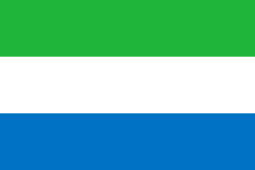
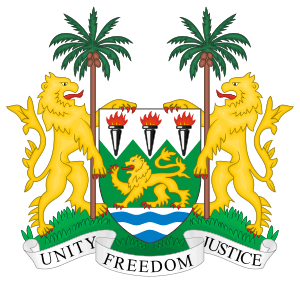
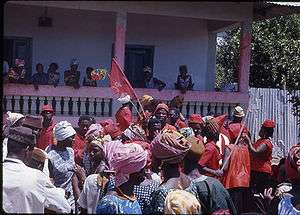
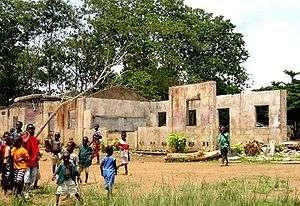
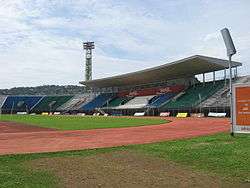
.svg.png)
Countries.png)